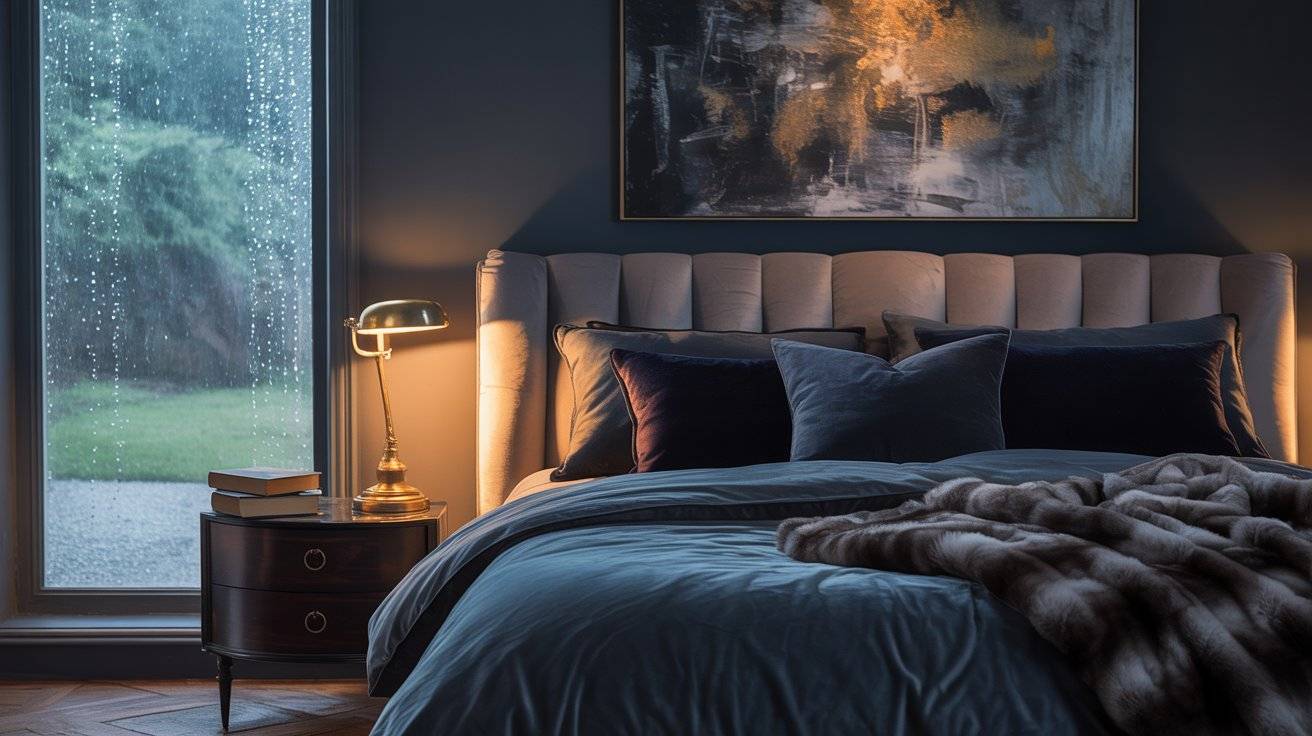Moody bedrooms is or about creating depth, warmth, and calm. A well-designed moody space feels like a retreat one that’s rich in texture, layered in light, and full of personal touches. Whether you live in a large home or a small apartment, it’s possible to create a moody bedroom that feels dramatic yet cozy.
This guide walks you through 23 real and doable ideas to help you design a bedroom that feels grounded and inviting. You’ll find inspiration in colors, lighting, furniture, and finishing details all chosen to help you turn your space into something that feels calm, intentional, and deeply yours.
Let’s explore how to get the look, without overcomplicating it.
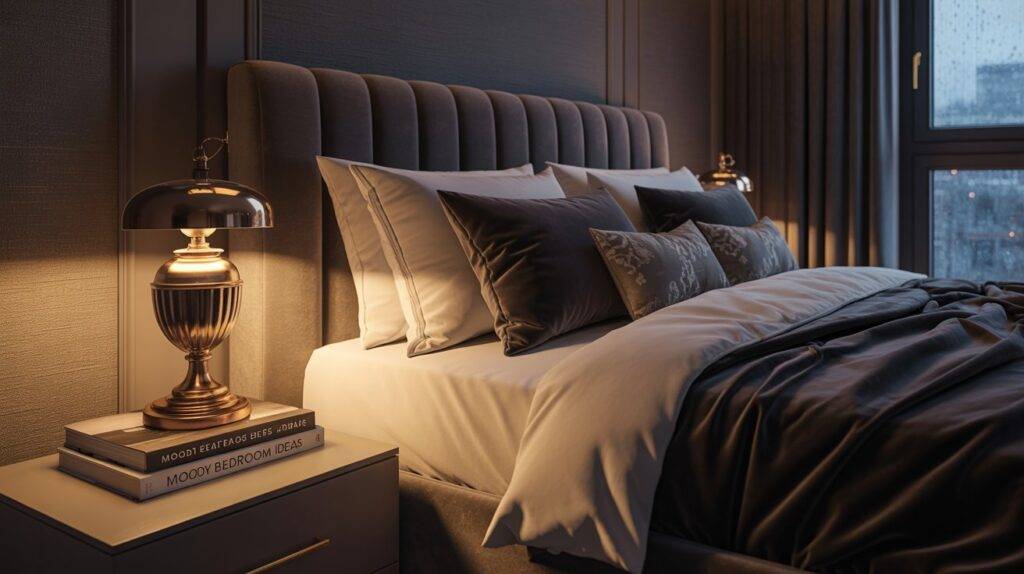
Choose Deep, Rich Wall Colors
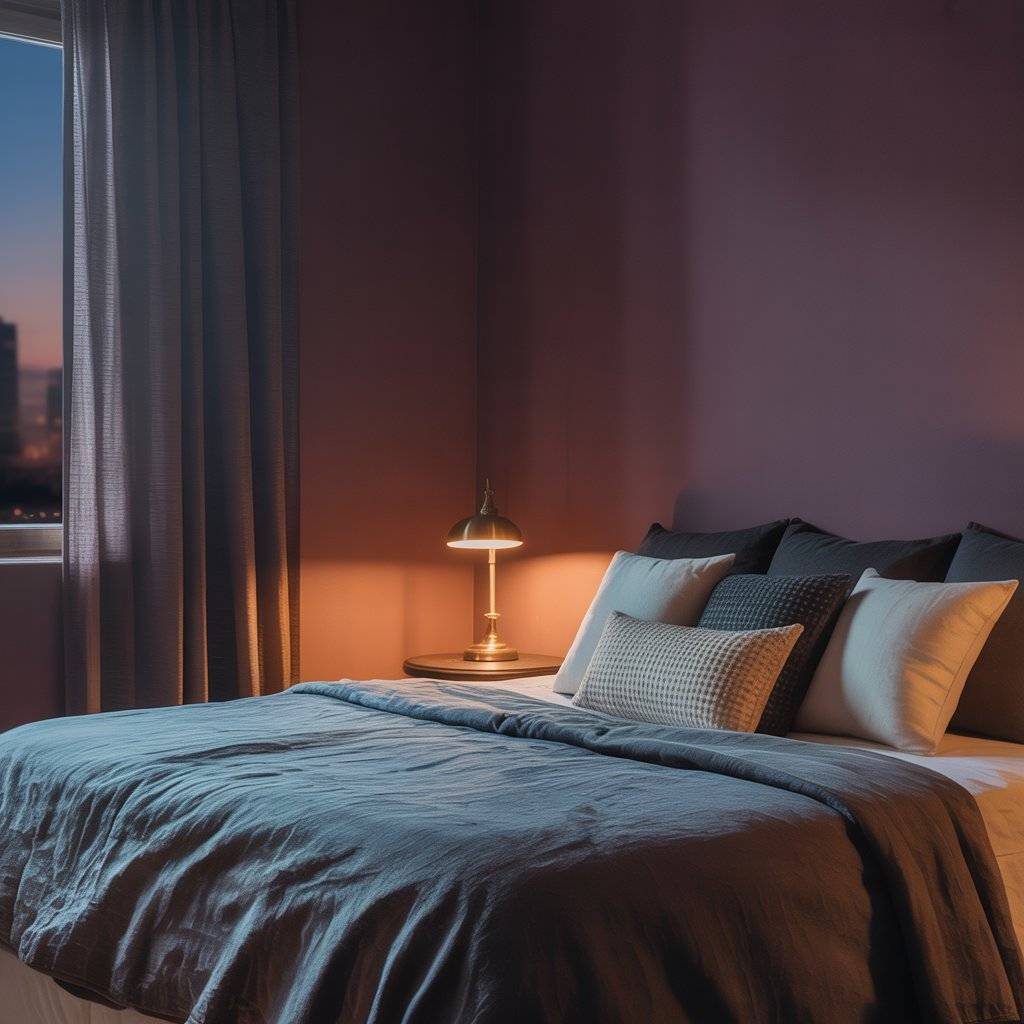
One of the easiest ways to create a moody bedroom is with color. Deep hues like charcoal, navy, forest green or muted plum instantly add depth and calm. Whether you paint all four walls or just one, these tones create a cocoon-like feeling.
They work well with both natural light and dim evening lighting. Matte or eggshell finishes work well than gloss less shine means a softer, more restful look.
If painting feels like too big a step, try peel-and-stick wallpaper in a dark print or texture. This idea is about setting the mood with color and building the rest of the room around that tone.
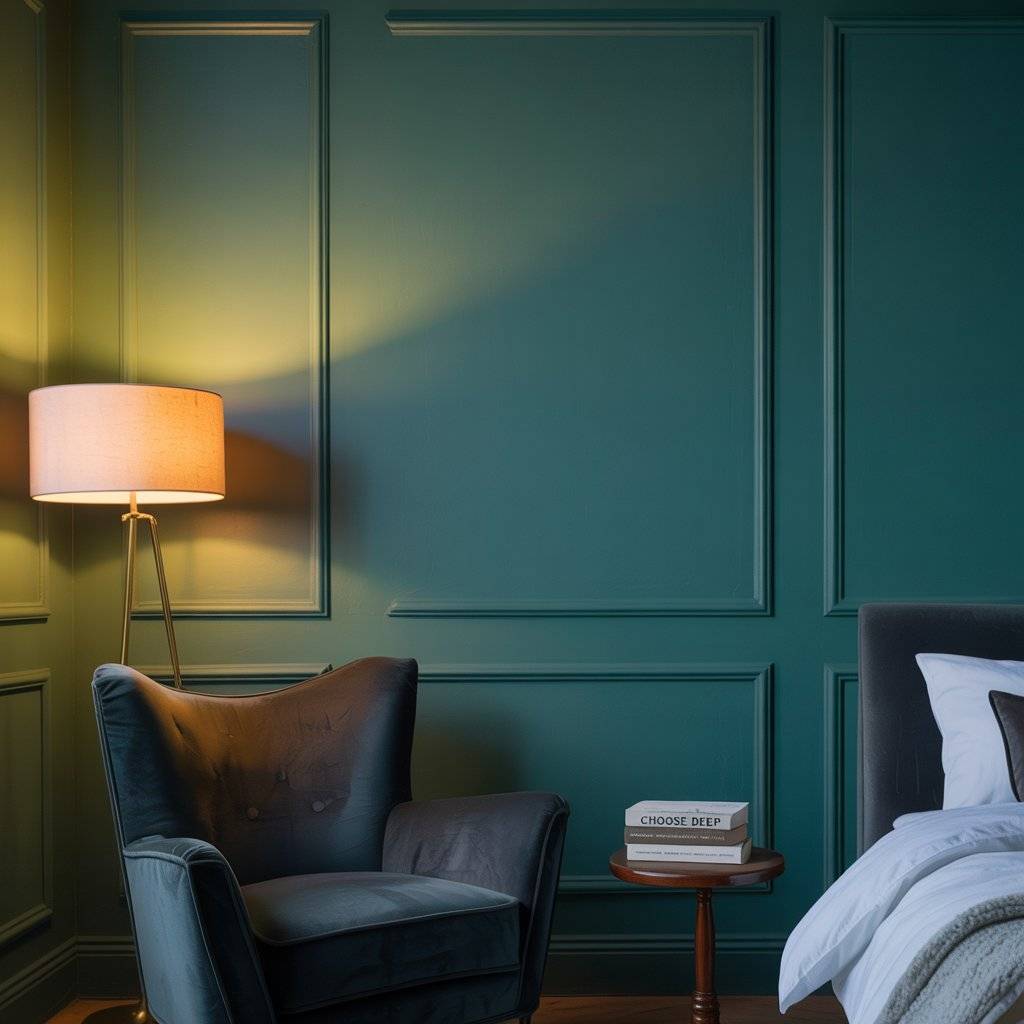
Layer with Soft, Ambient Lighting
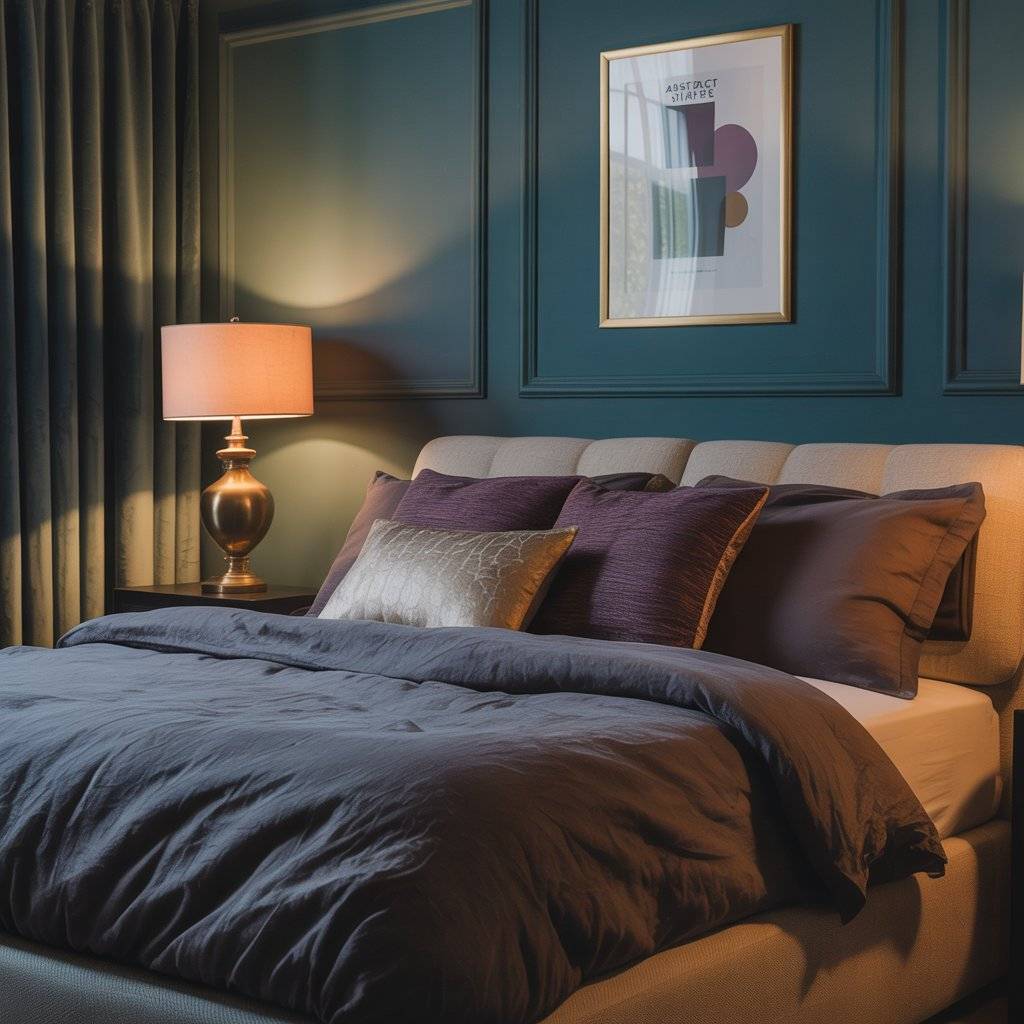
Lighting is key in a moody space. Skip overhead brightness and focus on warm, layered light. Use table lamps, floor lamps, sconces, or even string lights. Try bulbs with a warm color temperature around 2700K so the light feels soft and cozy.
If your room has natural light during the day, balance it with heavier curtains to keep the space feeling enclosed. Don’t forget dimmers.
A dimmable lamp or switch lets you adjust the feel of the room throughout the day. The right lighting setup helps the whole space feel slower, quieter, and more peaceful.
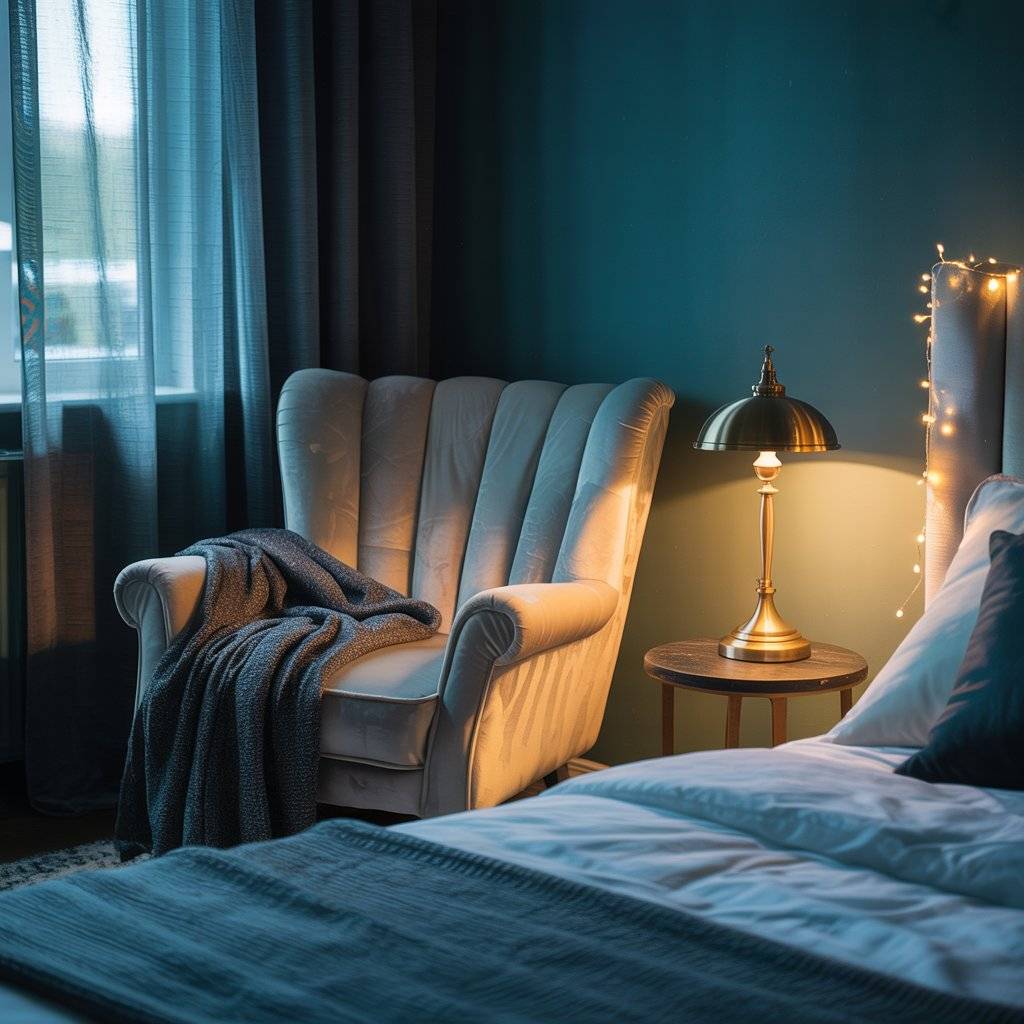
Add a Moody Accent Wall with Texture
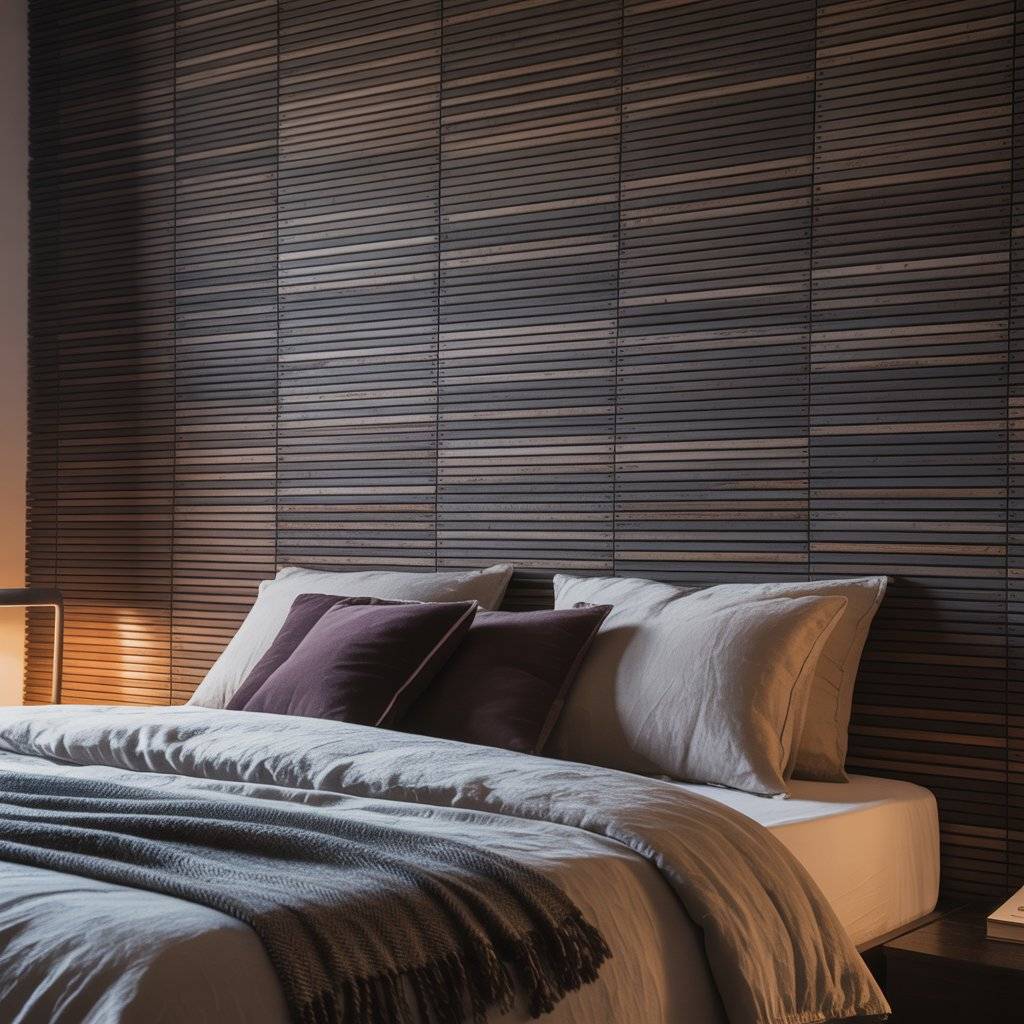
If you’re not ready to commit to dark walls throughout, a textured accent wall can bring the mood without overwhelming the space. Think wood slats, moody-toned shiplap, dark floral wallpaper, or even a rich velvet wall panel.
Place it behind your bed or along the wall you face when entering the room. The texture adds depth and visual interest, while the color grounds the design.
It’s a great middle step between plain and fully dramatic. Plus, you can switch it out over time if your style changes.
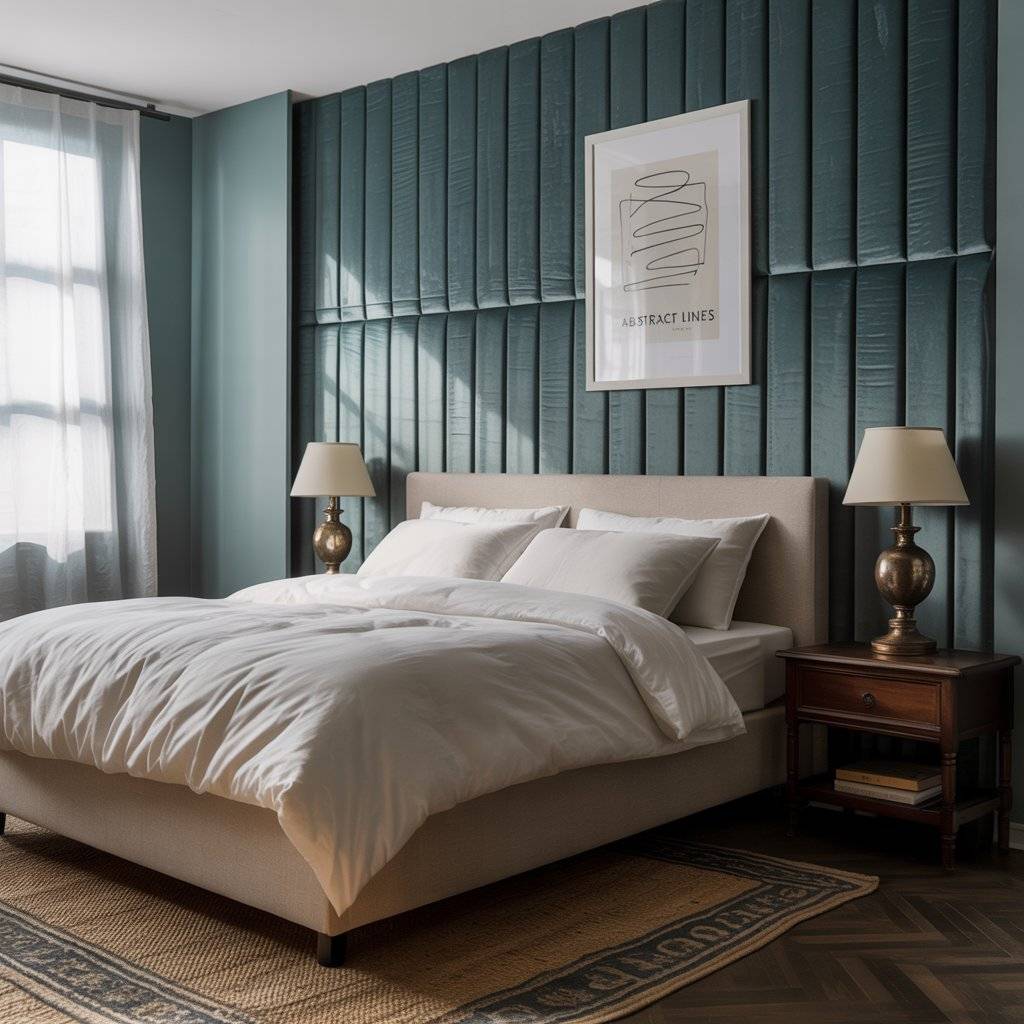
Use Dark Wood Furniture with Clean Lines
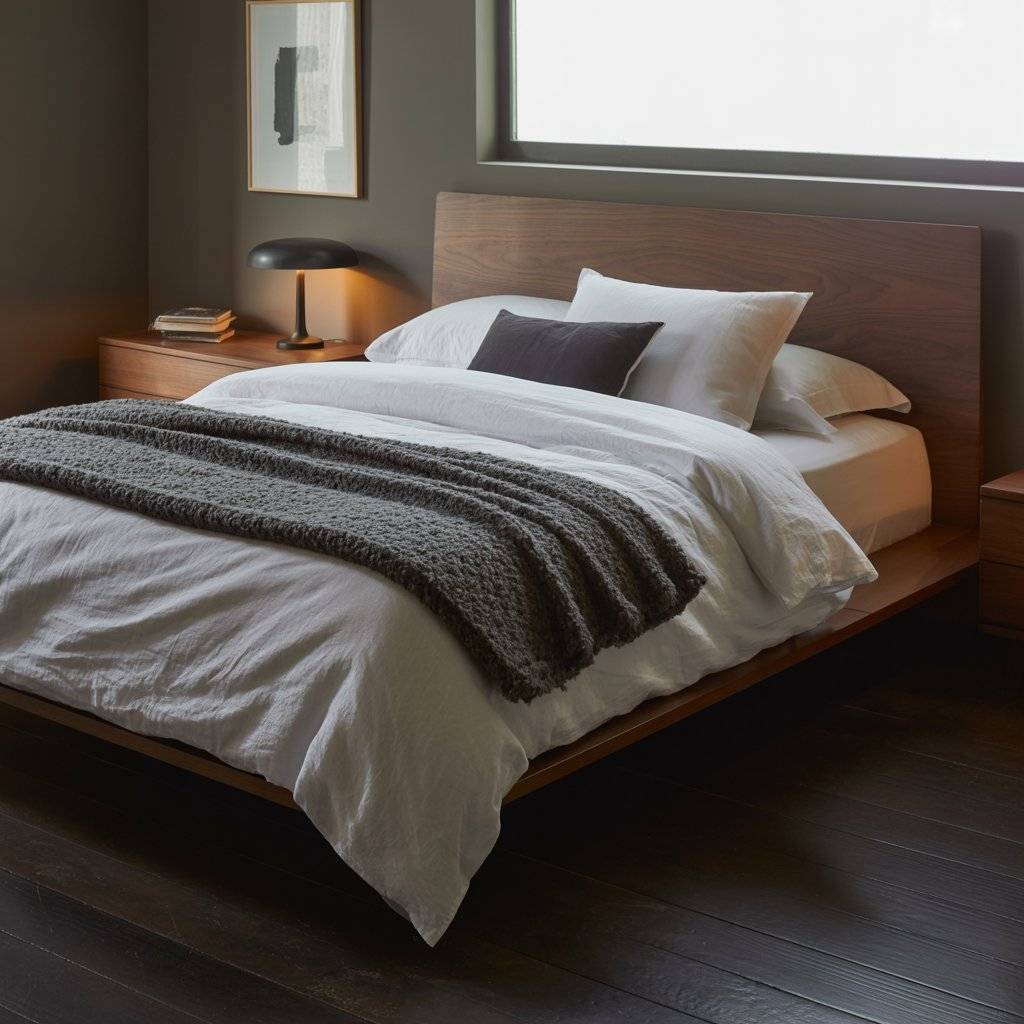
Furniture can support the moody vibe, especially if it features darker woods like walnut, espresso, or black oak. Clean lines and simple shapes work best in moody bedrooms they keep the room from feeling too heavy or cluttered.
Look for low-profile bed frames, minimal nightstands, and dressers with subtle finishes. If your furniture is lighter but still in good condition, consider refinishing or staining it. This is an idea that brings weight and warmth to the space, without relying on large or trendy pieces.
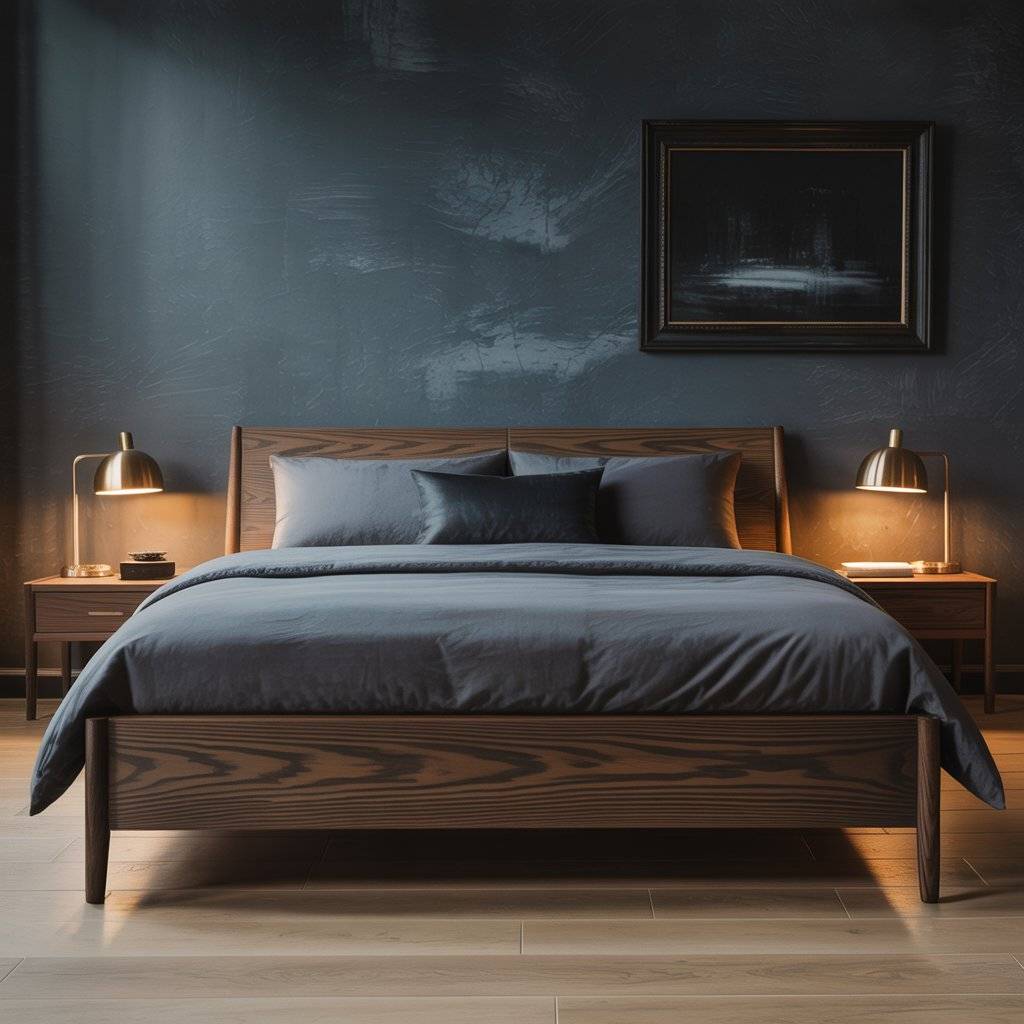
Incorporate Heavy, Textured Bedding
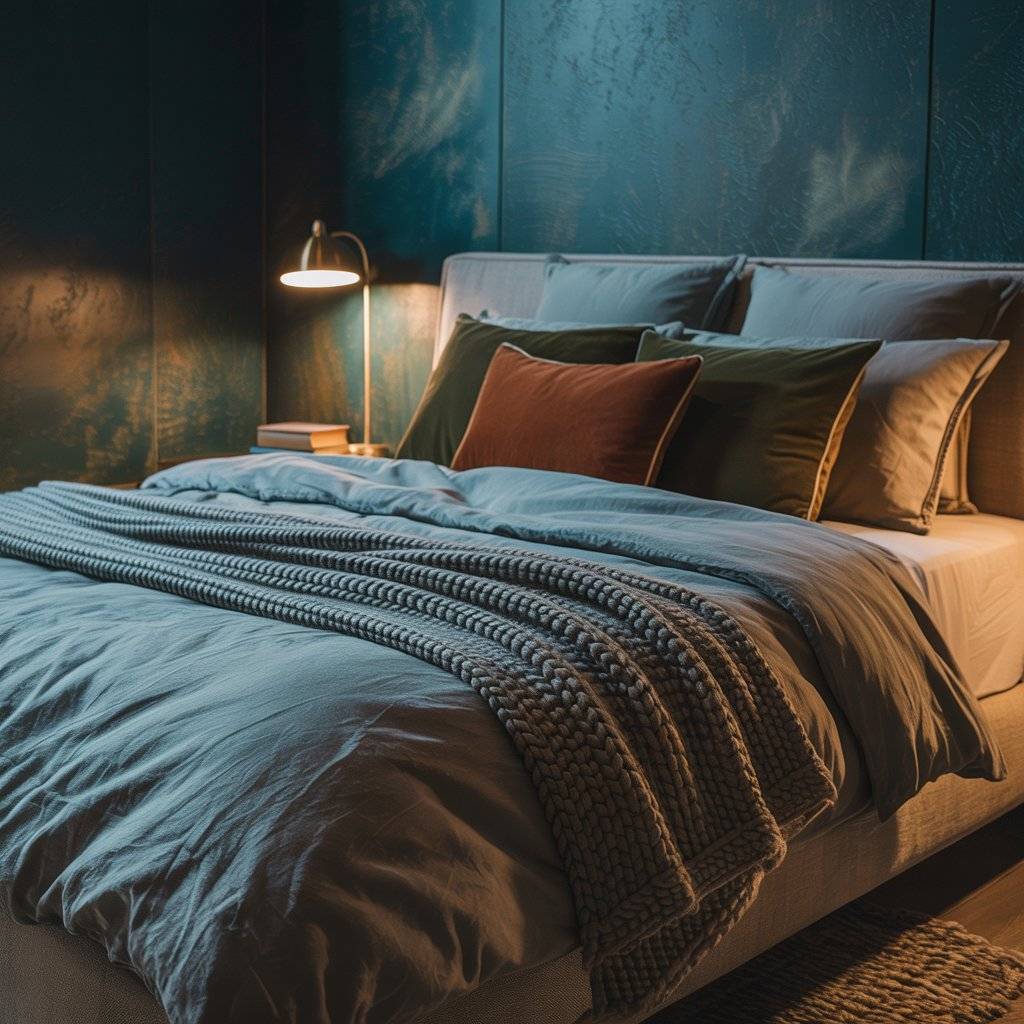
Bedding is one of the easiest ways to bring a cozy, dramatic feel into your bedroom. Think linen duvets, chunky knit throws, velvet pillow covers, or cotton quilts in deep shades like slate, moss, or rust.
You don’t need a full matching set mix and match layers in the same color family for a relaxed but thoughtful look. Stick to three or four main textures and rotate with the seasons. Good bedding makes the bed feel inviting and anchors the entire room in comfort.
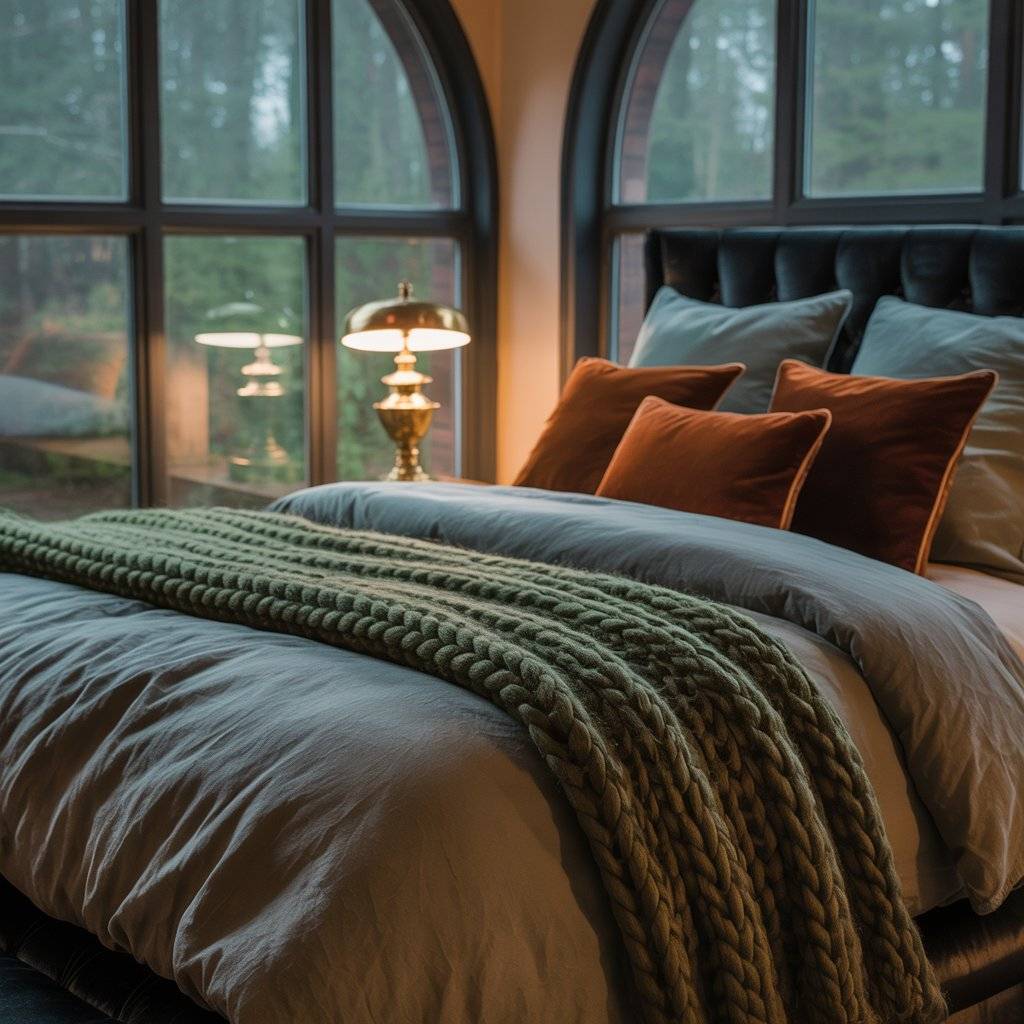
Go Matte with Finishes
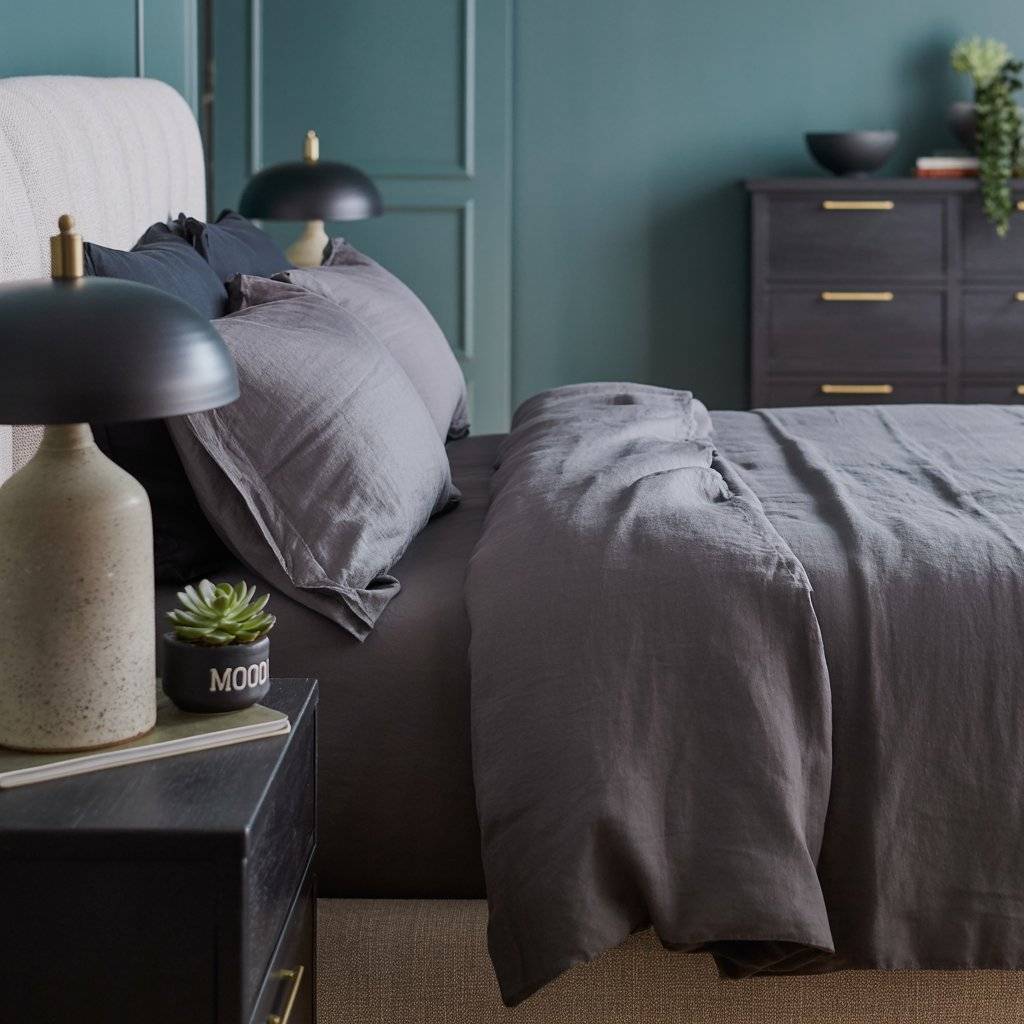
Matte finishes absorb light instead of reflecting it, helping a moody bedroom feel softer and more grounded. Look for matte-finished paint, metal lamp bases, ceramic planters, or even matte hardware on your dresser drawers.
These small, flat-sheen details reduce visual noise and help the eye rest. When you avoid high-shine elements, the room takes on a richer, quieter tone ideal for rest. This subtle shift in finish can have a big effect on the overall mood.
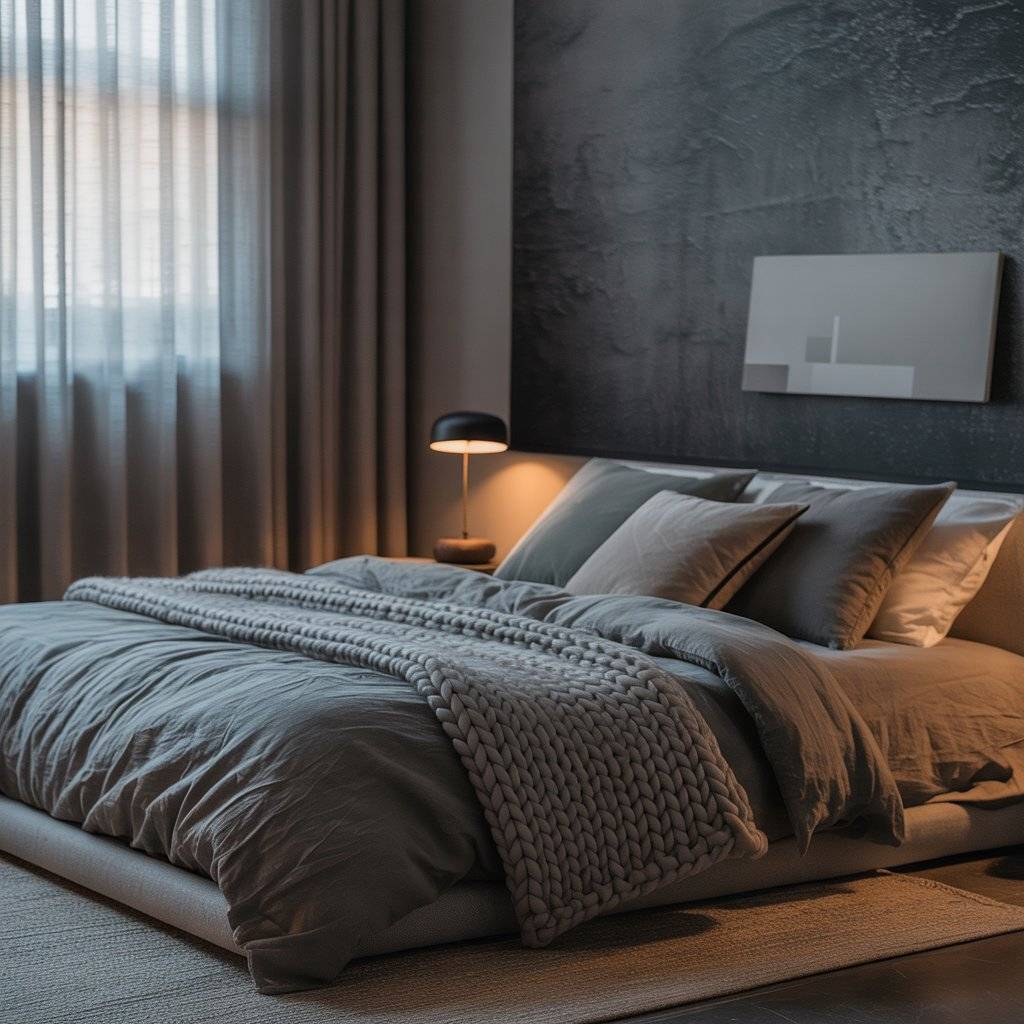
Bring in Black Accents
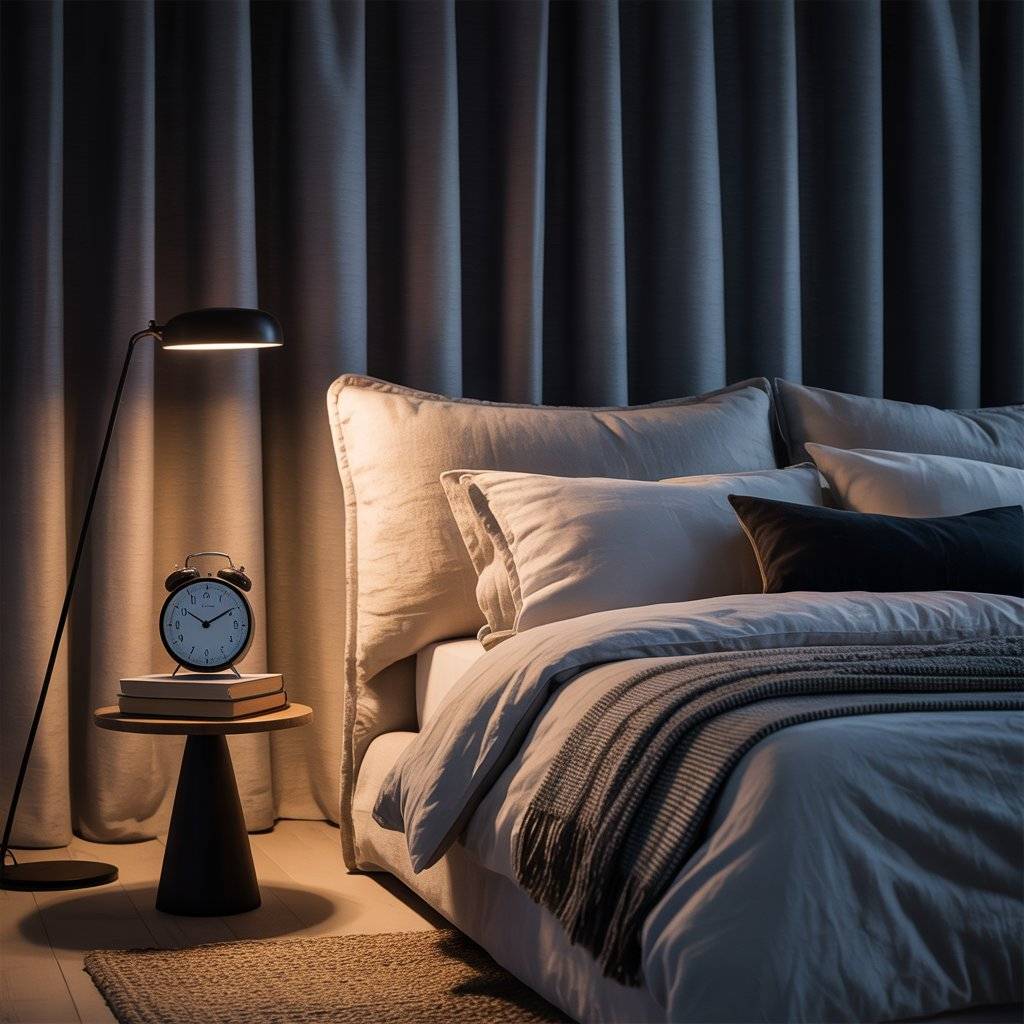
You don’t need a black room to get moody, but small black accents add definition and contrast. Think a black picture frame, a sleek side table, dark curtain rods, or a black floor lamp.
These details help ground the space and pair well with any moody color palette. If your room has lighter wood or neutral elements, adding black accessories creates balance without feeling overwhelming.
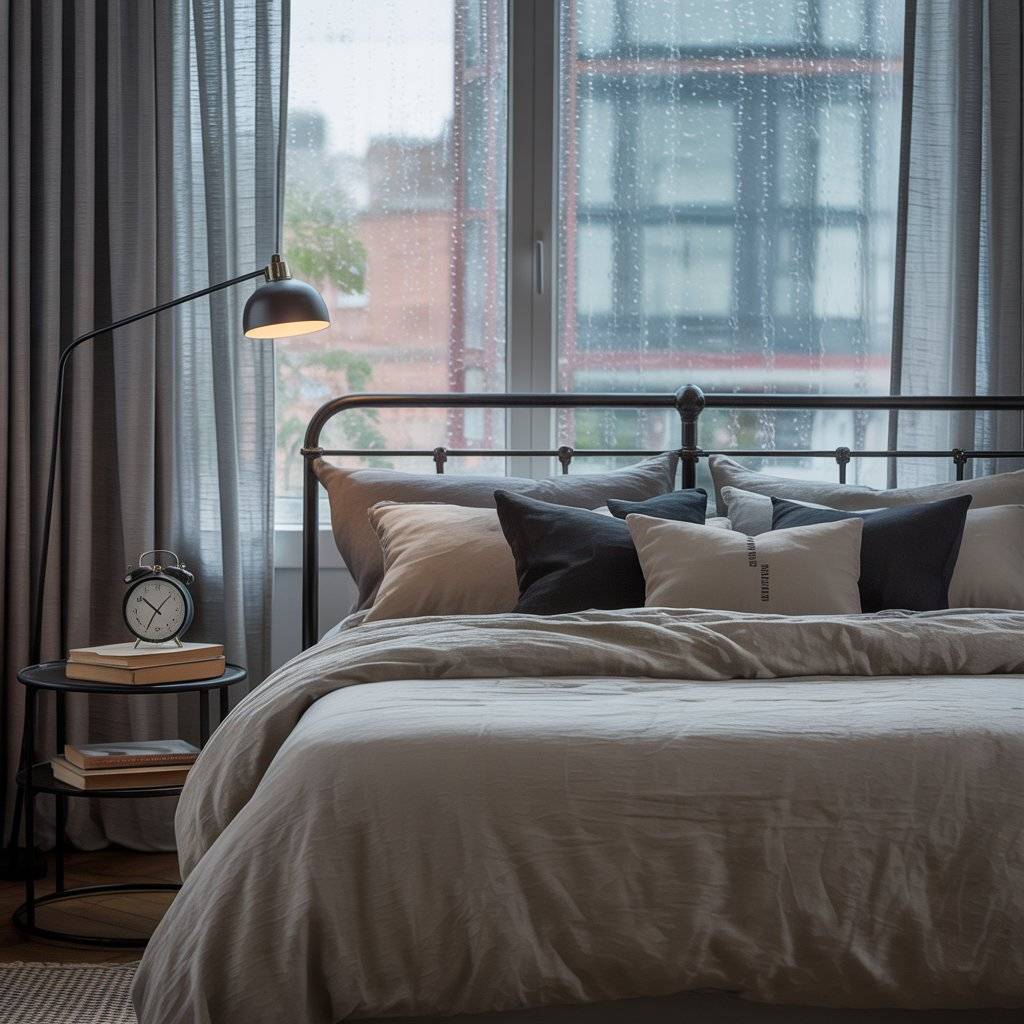
Try a Monochromatic Color Scheme
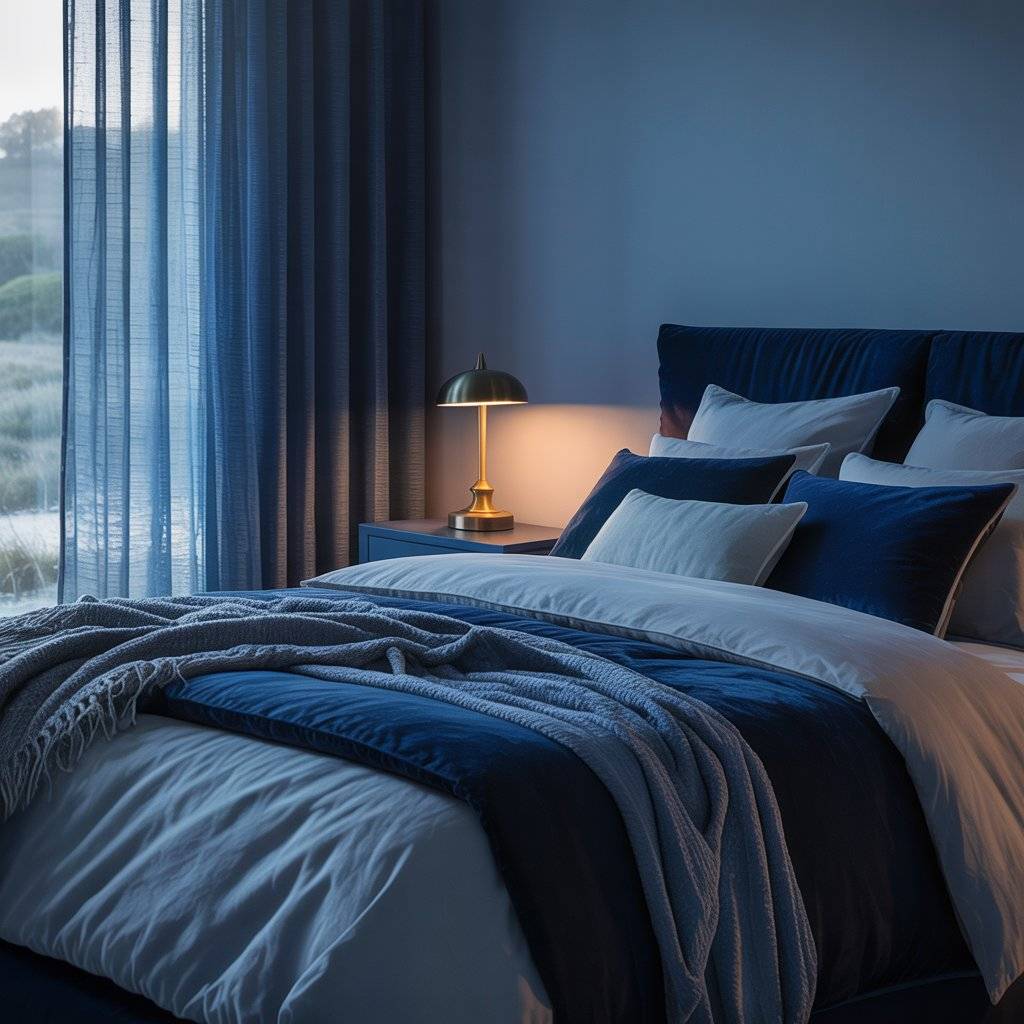
Choosing different shades of one color can create a soothing, dramatic effect. For example, layer navy walls with soft blue-gray bedding and indigo accessories.
Or use varying tones of forest green across furniture, curtains, and textiles. This approach keeps the space calm but visually interesting. It’s also easier to mix and match pieces when they stay within the same color family.
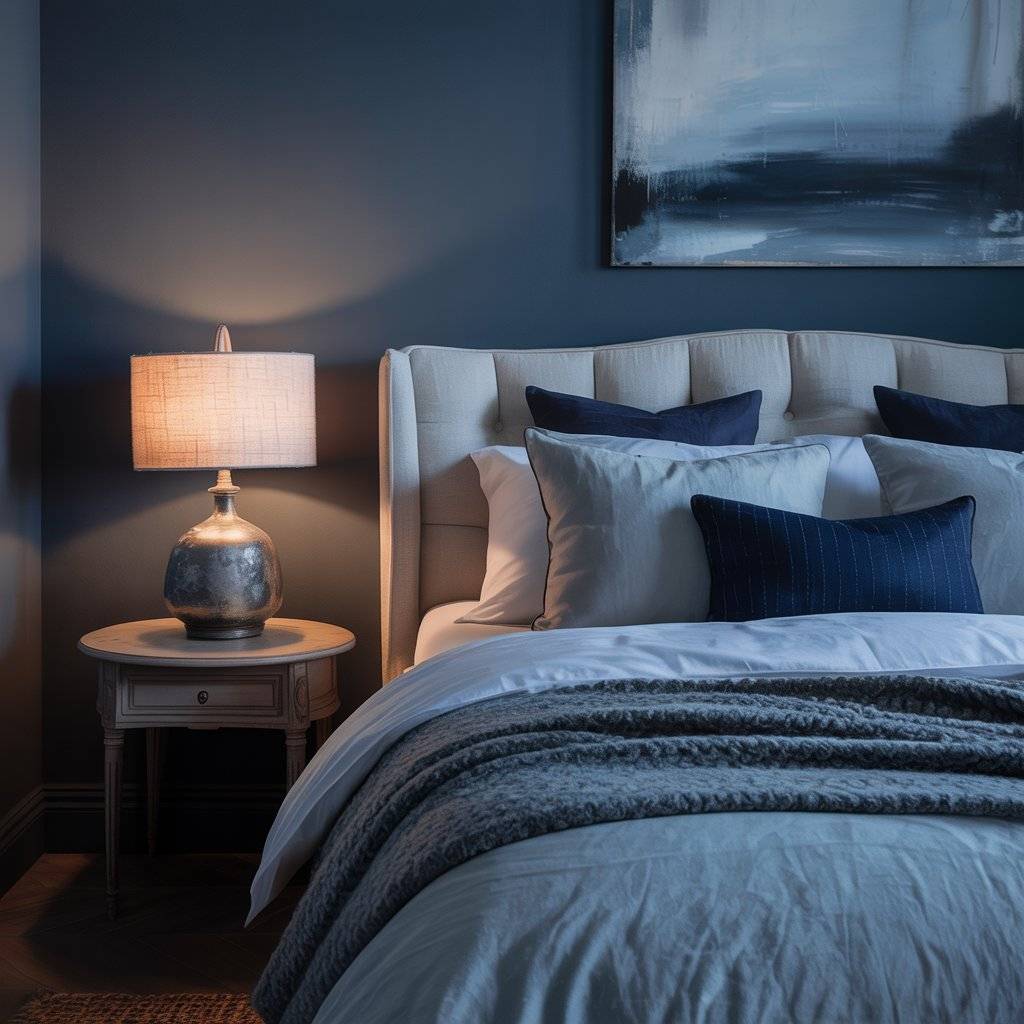
Embrace Heavy Drapes or Blackout Curtains
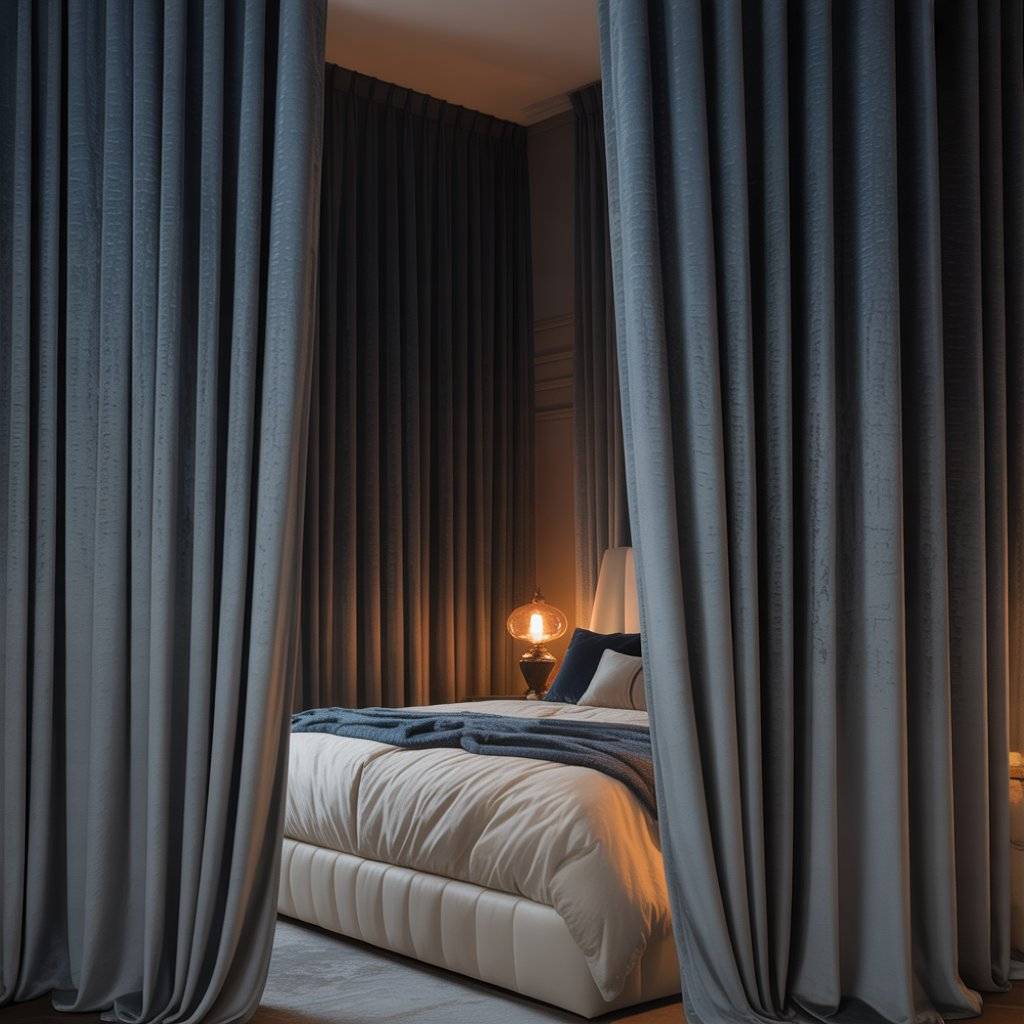
Moody bedrooms feel best when you can control the light. Heavy drapes or blackout curtains not only block sunlight but also add texture and softness.
Choose curtains in velvet, linen, or thick cotton in darker shades that match your palette. Floor-length styles feel elegant without being flashy. They help create that tucked-in, retreat-like feeling at any time of day.
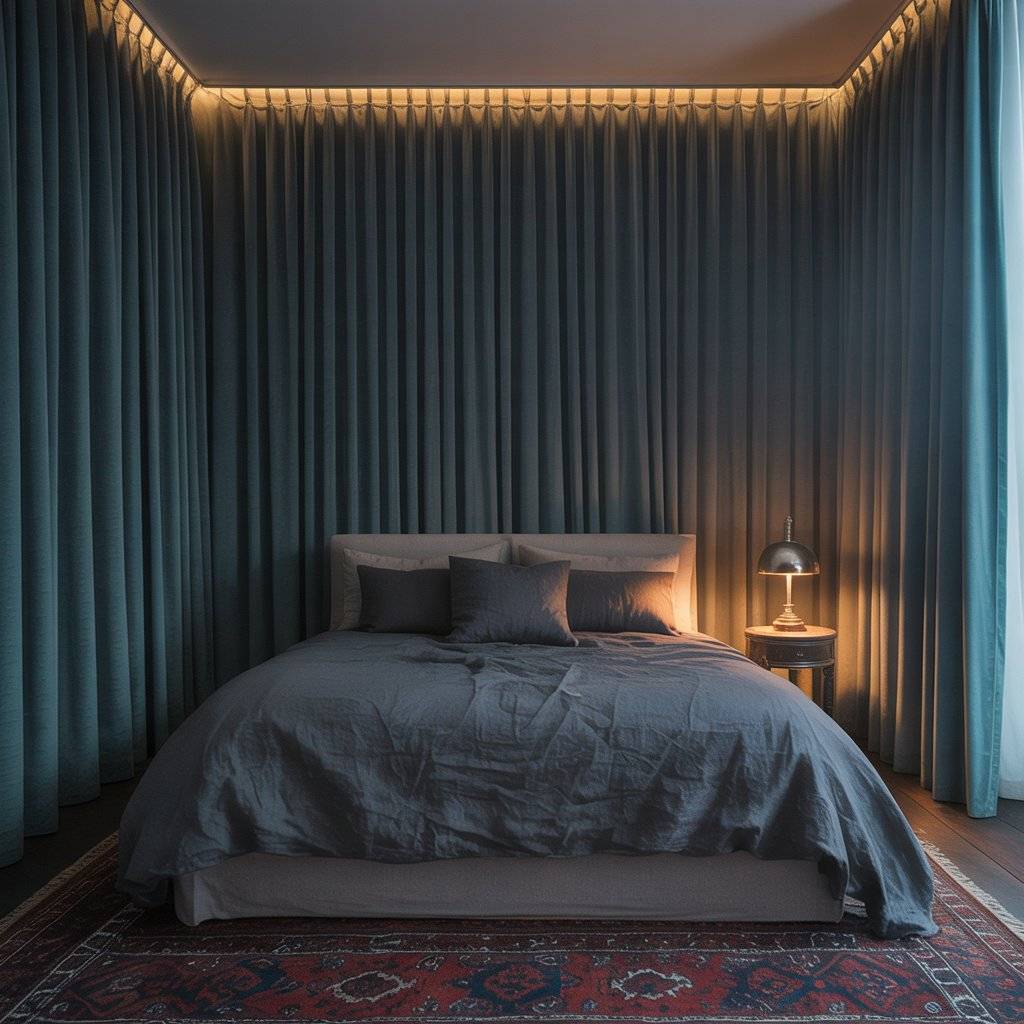
Use Natural Textures to Soften the Mood
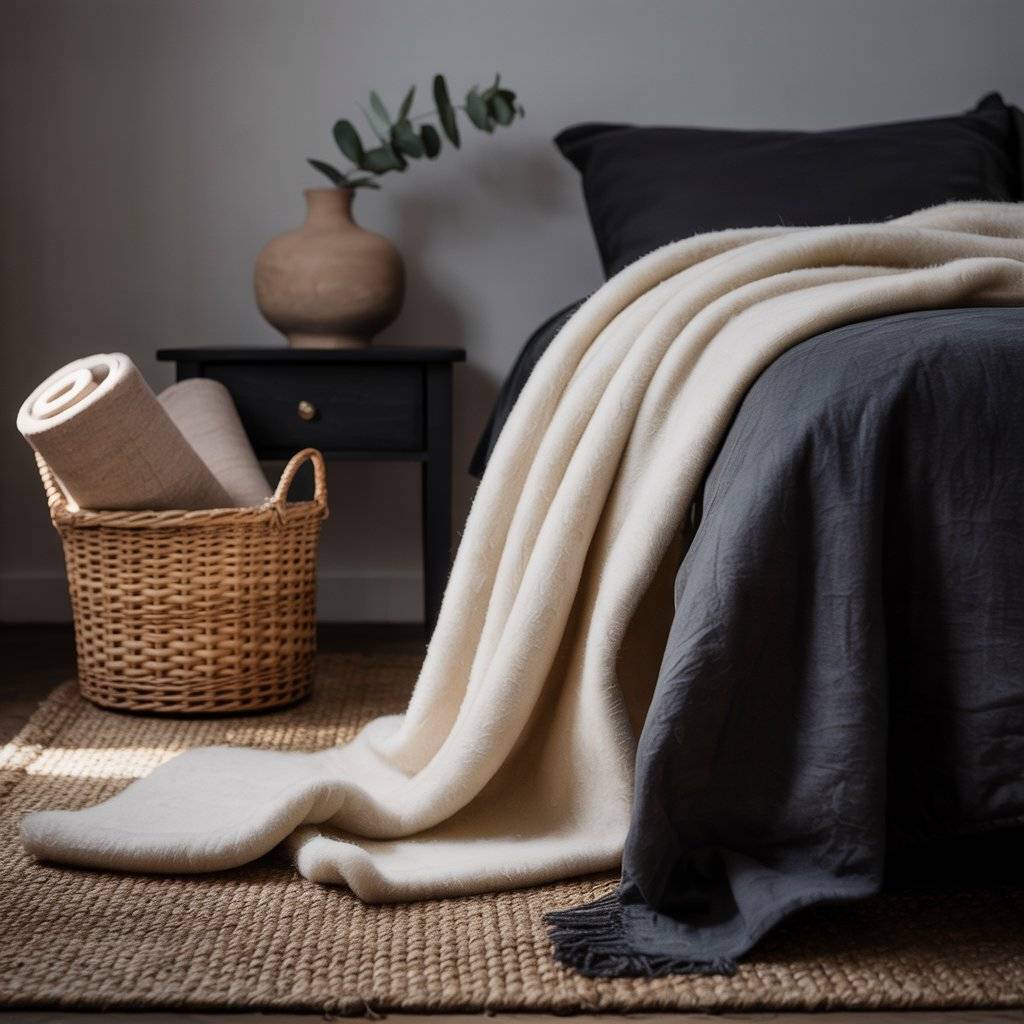
Dark rooms risk feeling cold without a balance of soft or organic textures. Woven baskets, jute rugs, clay pottery, or wool throws all help warm up the look.
These natural materials give the room a relaxed, earthy feel even when paired with deeper colors. The goal is balance: depth from the dark tones, comfort from the textures.
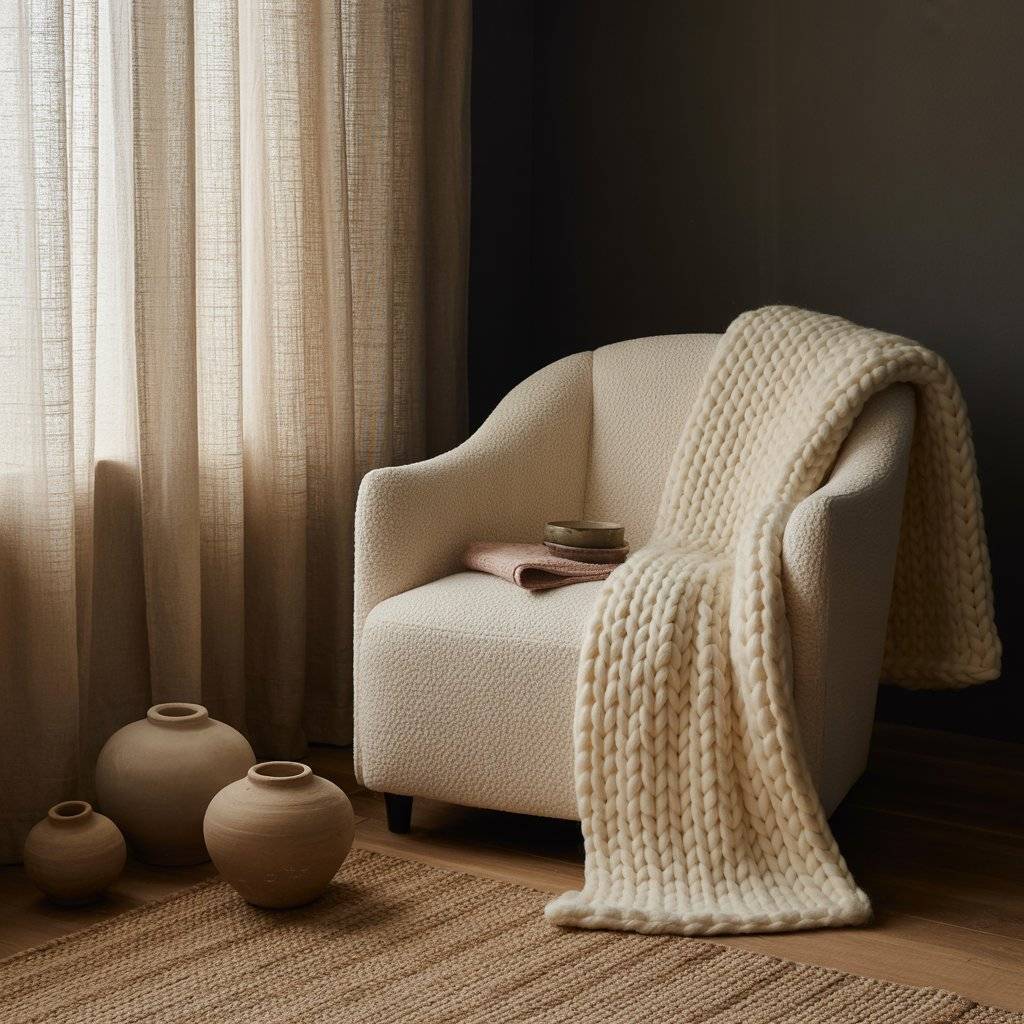
Add Wall Art with Deep Tones
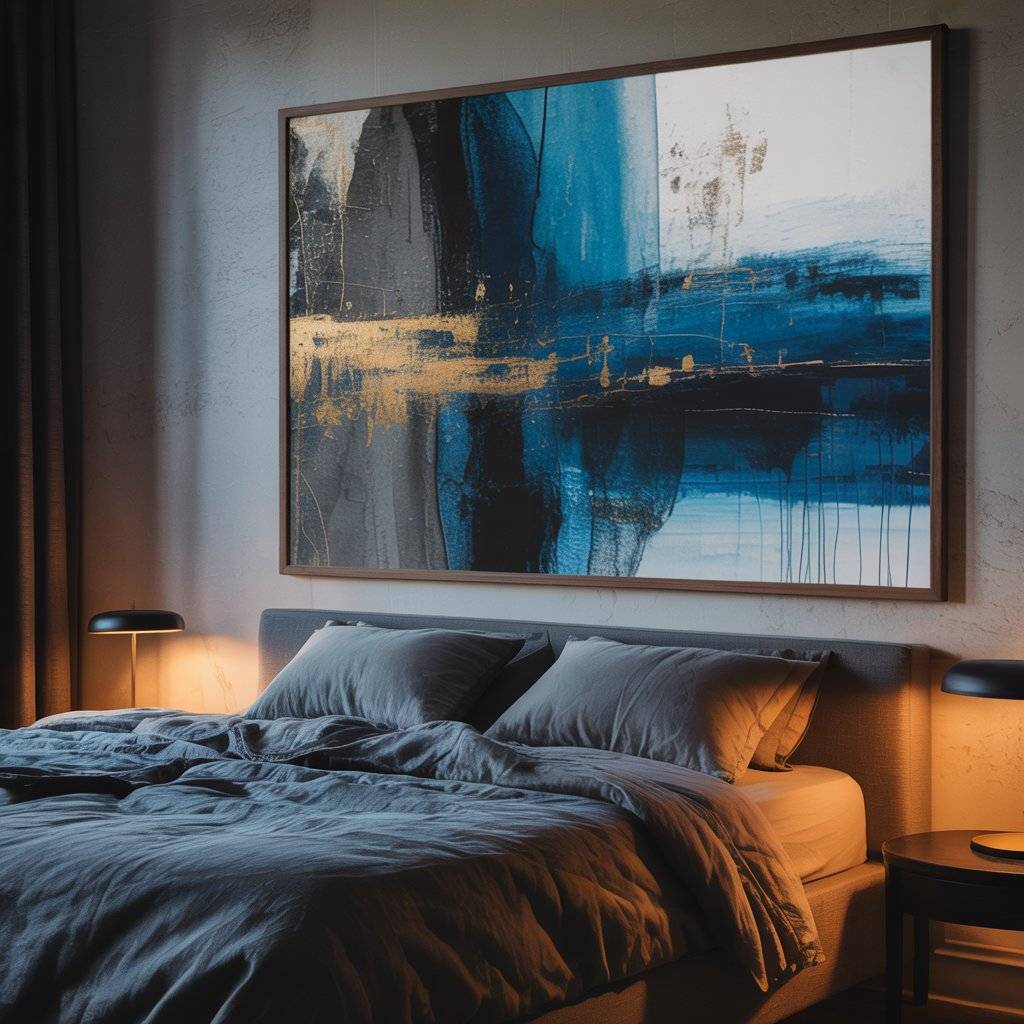
Look for art pieces that match your room’s moody tone think abstract prints, muted landscapes, or black-and-white photography. Larger-scale pieces add a focal point without crowding the space.
Frames in black, dark wood, or gold-toned metal keep the look refined. Art can tie your palette together while giving your bedroom a personal feel.
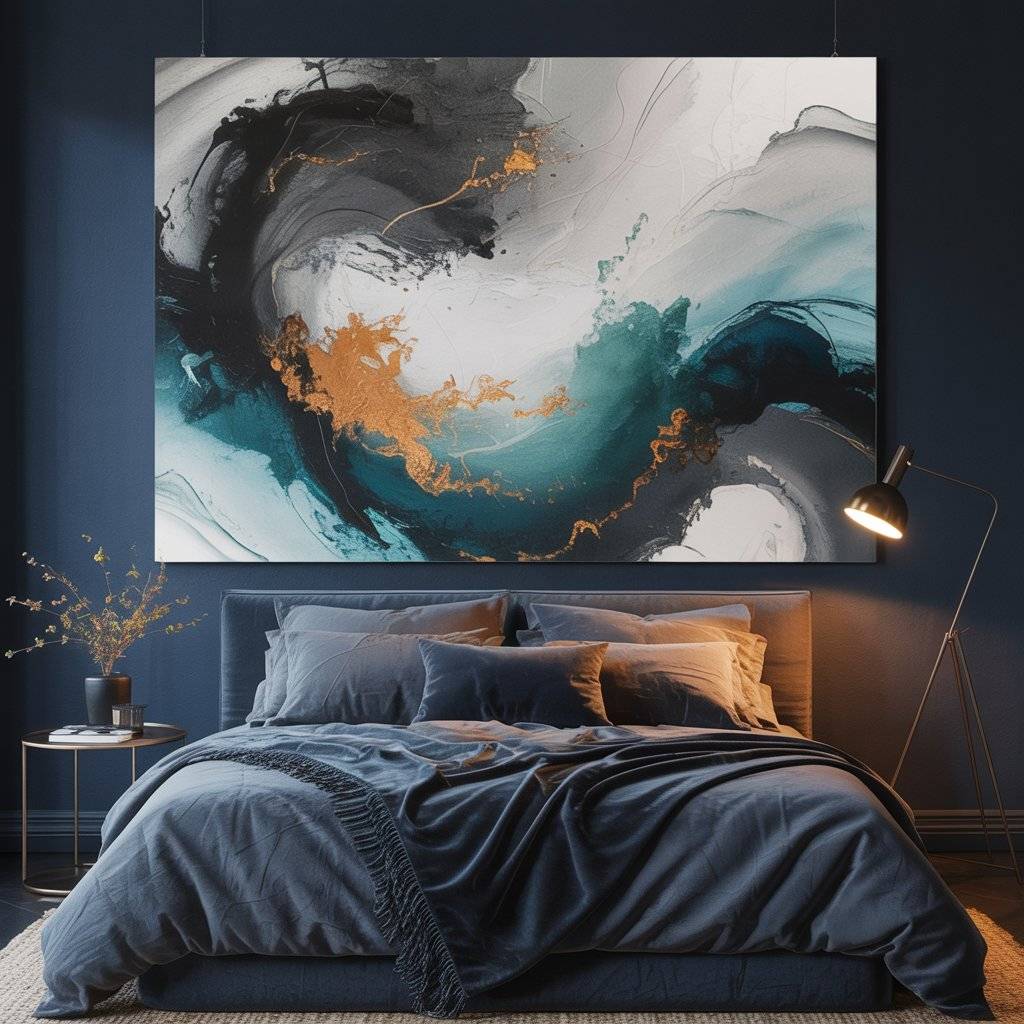
Use Scent to Complete the Atmosphere
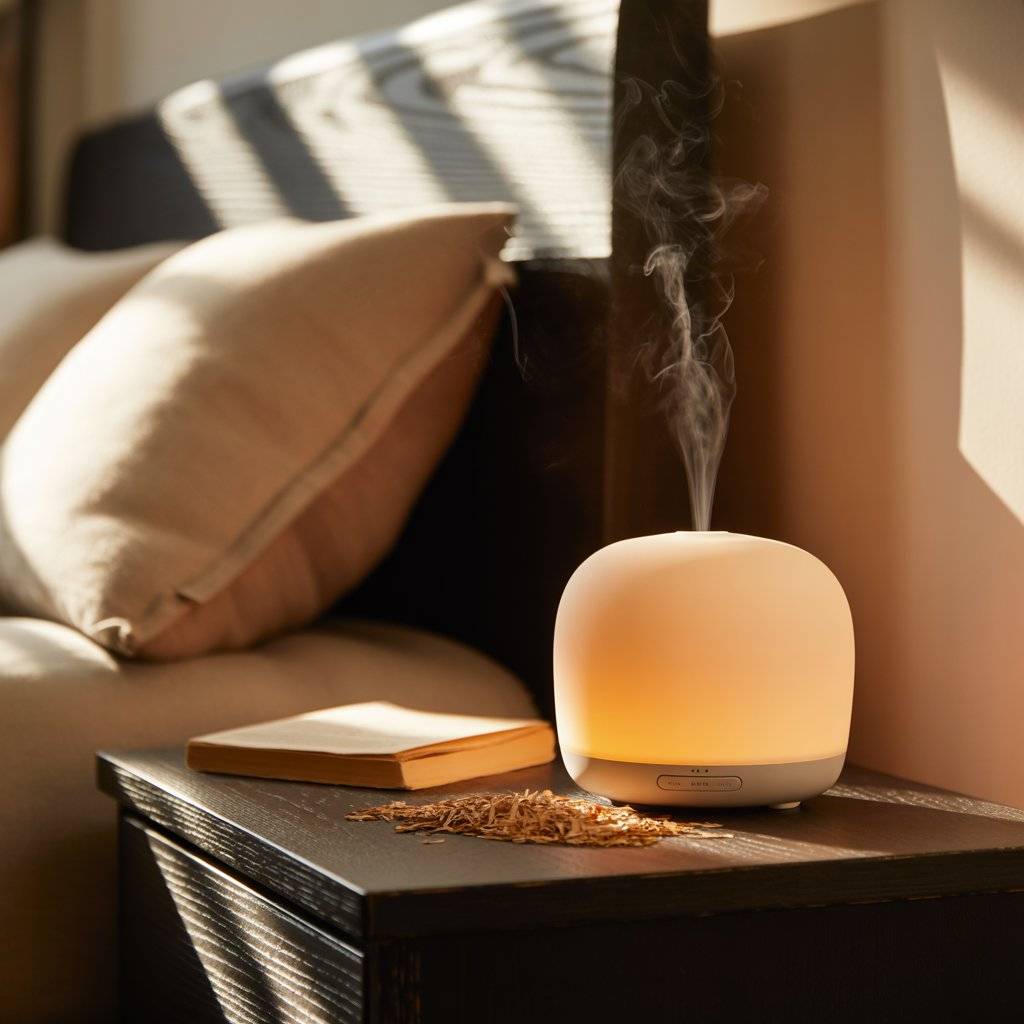
A room’s mood isn’t just visual. Scent adds an emotional layer. Choose candles, essential oils, or incense in earthy, calming scents like sandalwood, cedar, or amber.
Use a diffuser or place candles in ceramic holders that match your room’s style. Scent is subtle but powerful it helps your bedroom feel finished and invites you to slow down.
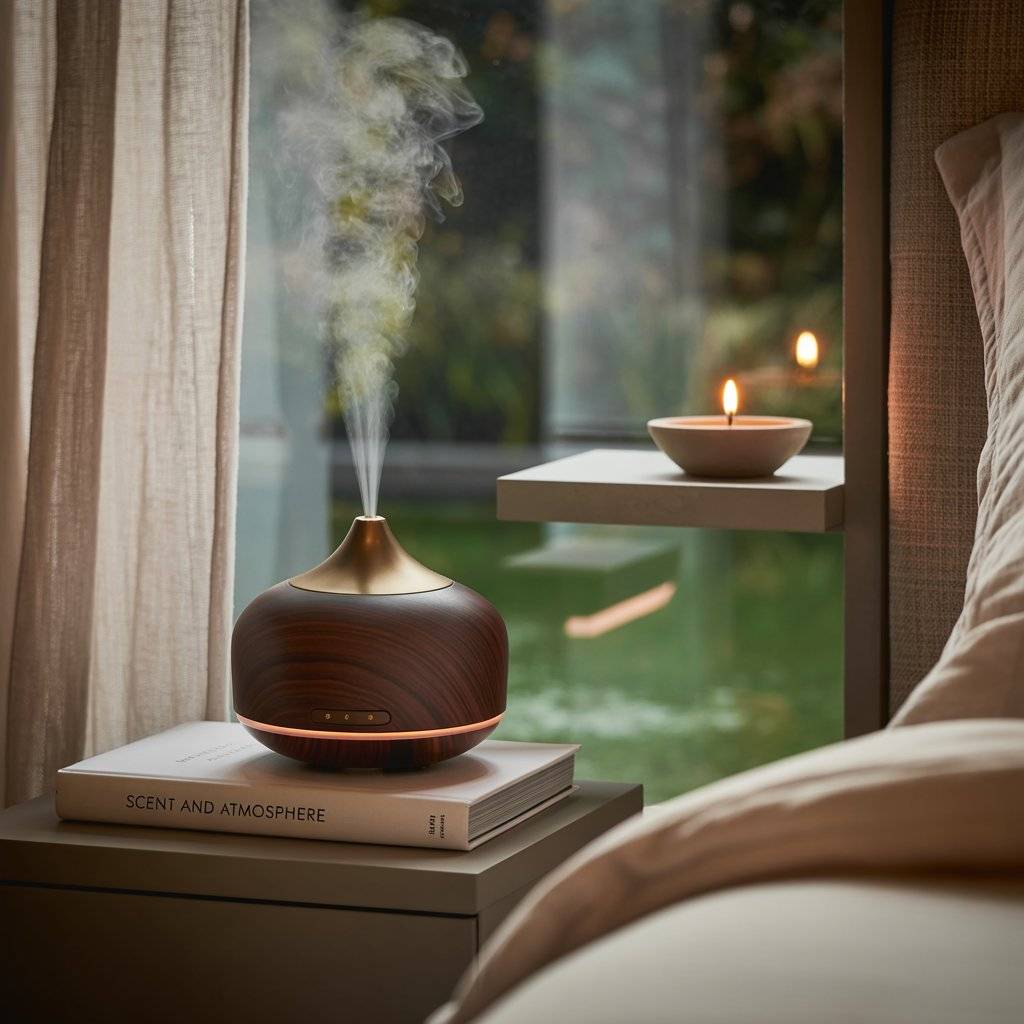
Choose a Statement Headboard
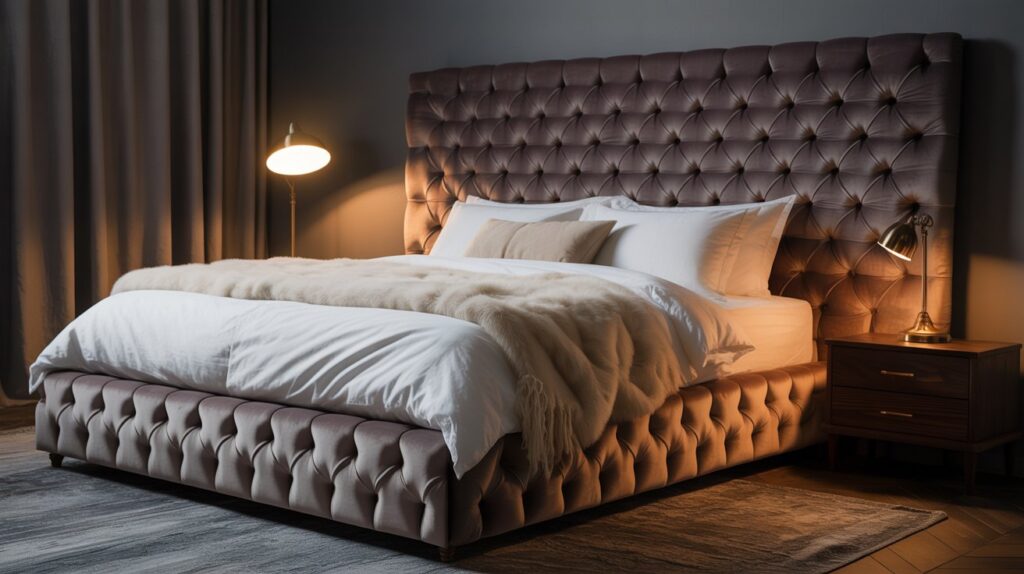
A bold headboard becomes the anchor of a moody bedroom. Go for something upholstered in velvet, linen, or leather, or try a wood headboard with a carved or paneled look.
It doesn’t have to be ornate just something that brings texture and height to your space. A headboard draws the eye and gives your bed a sense of purpose and place.
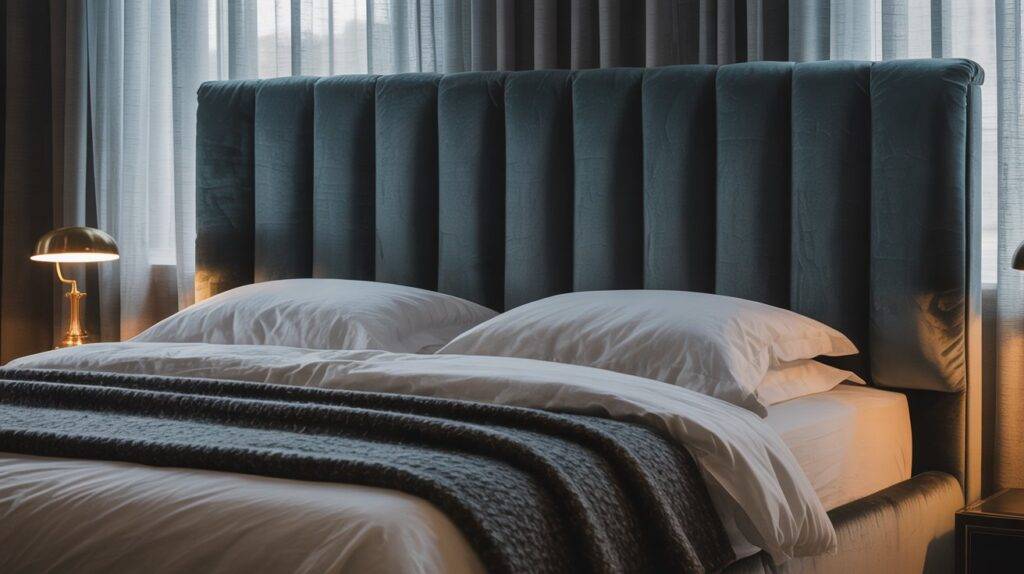
Add Vintage or Aged Elements
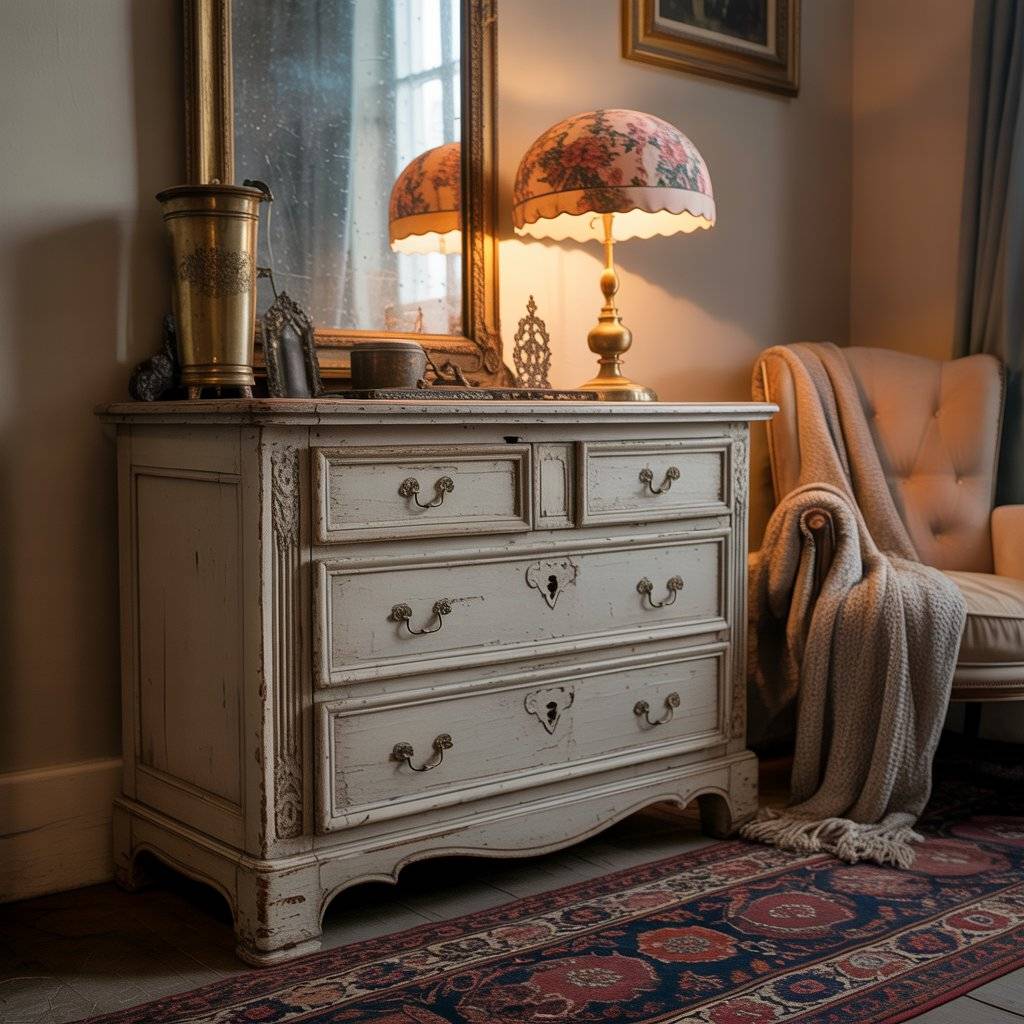
Mixing in vintage pieces like a worn wood dresser, old-style lamp, or brass mirror adds character. These pieces keep a dark room from feeling too new or too flat.
Flea markets, antique shops, or even hand-me-downs can bring in warmth and uniqueness. The goal isn’t to decorate with trends but to find things that feel personal and grounded.
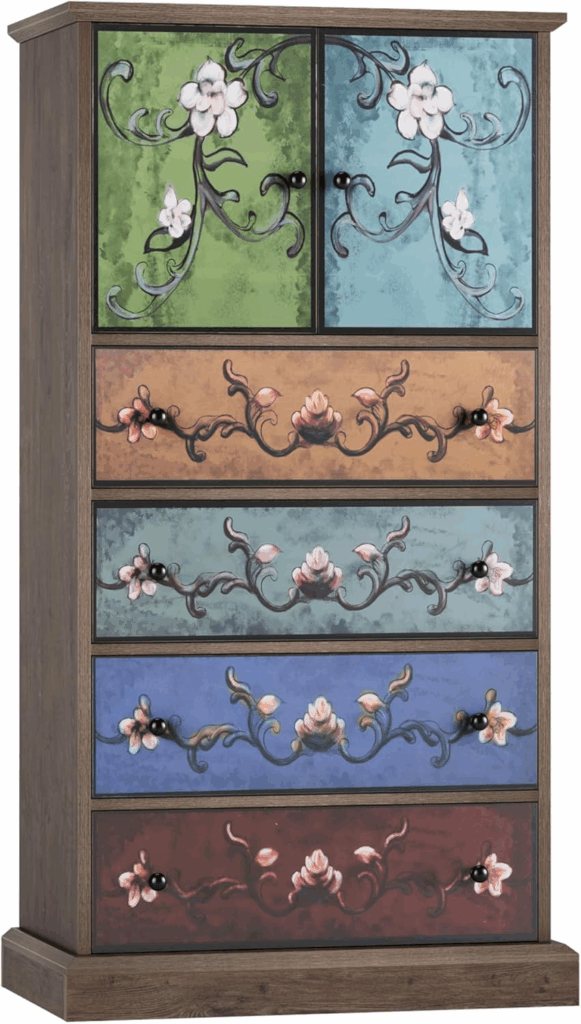
Keep the Clutter Low
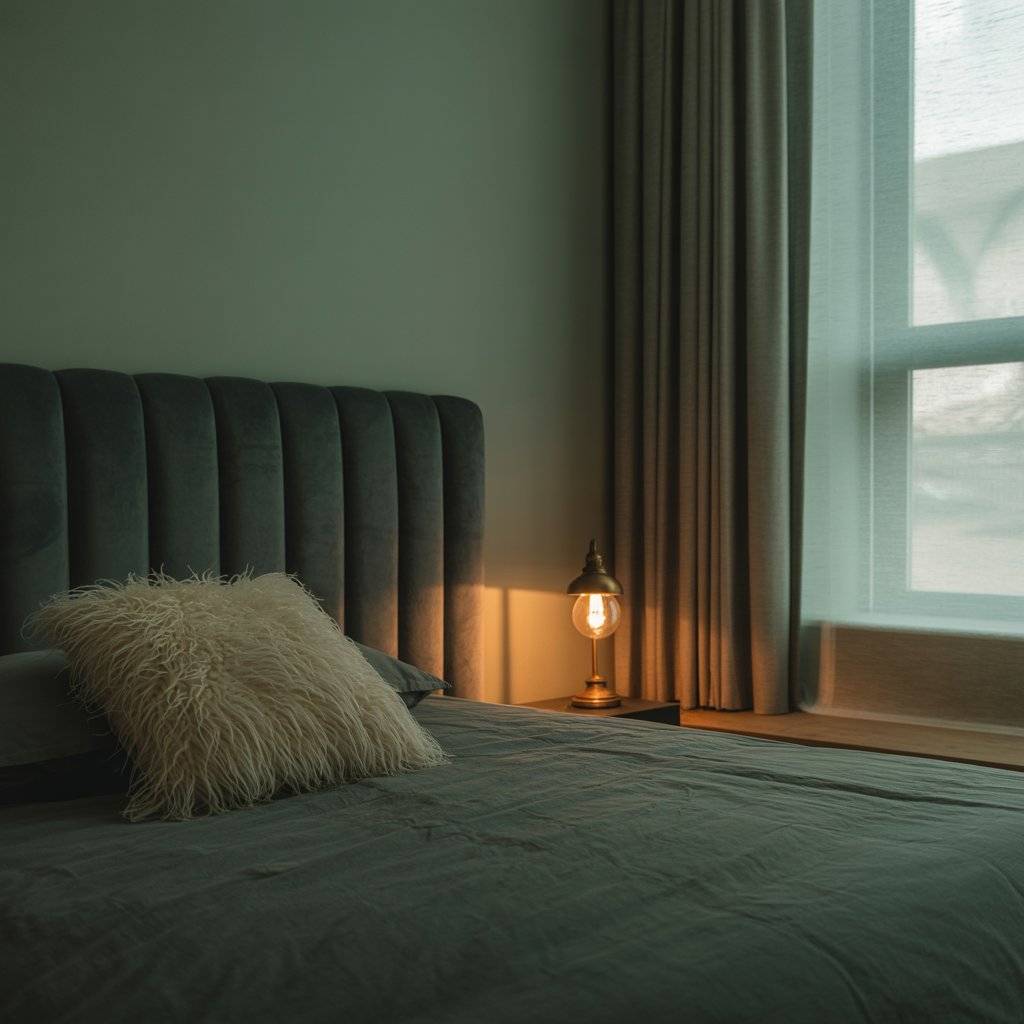
Too much clutter works against the calming feel of a moody bedroom. Keep surfaces clean and decor intentional. Use closed storage where possible, and display only a few favorite items.
A tidy space lets the textures, lighting, and color palette shine through. It also makes the room easier to wind down in at the end of the day.
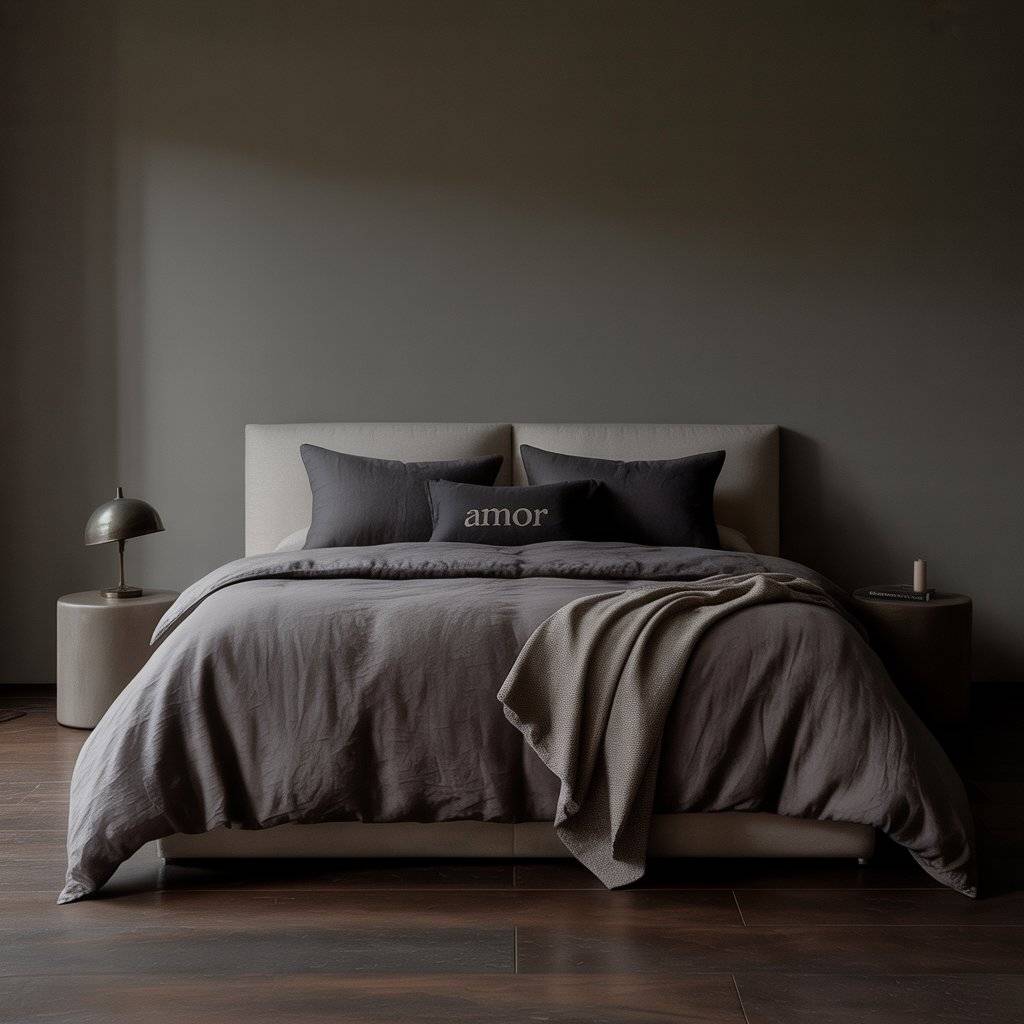
Use Low Beds and Furniture

Lower furniture adds to the cozy, grounded feel. Look for platform beds or floor-level side tables. This helps the room feel calm and settled, especially in smaller spaces. Low furniture also makes high ceilings feel less overwhelming and works well with layered lighting and textiles.
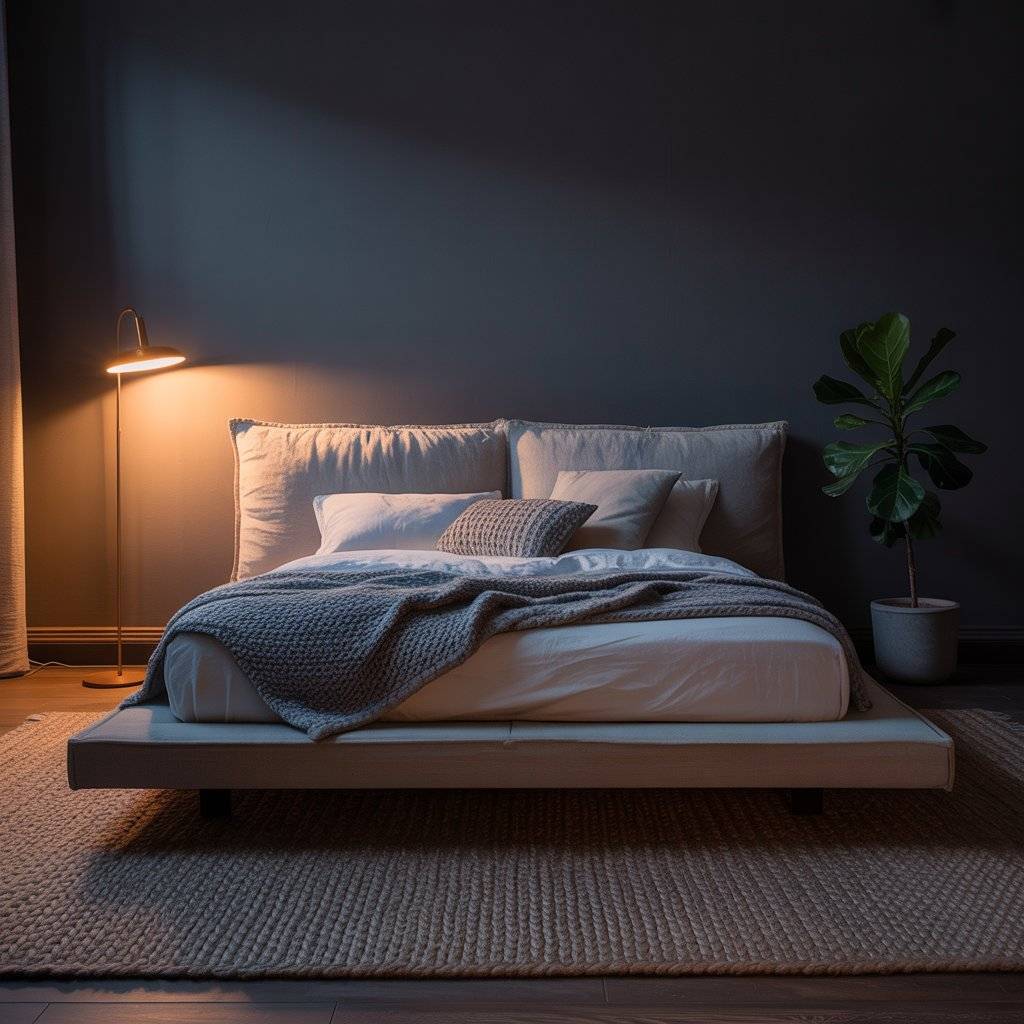
Add an Overhead Light with Character
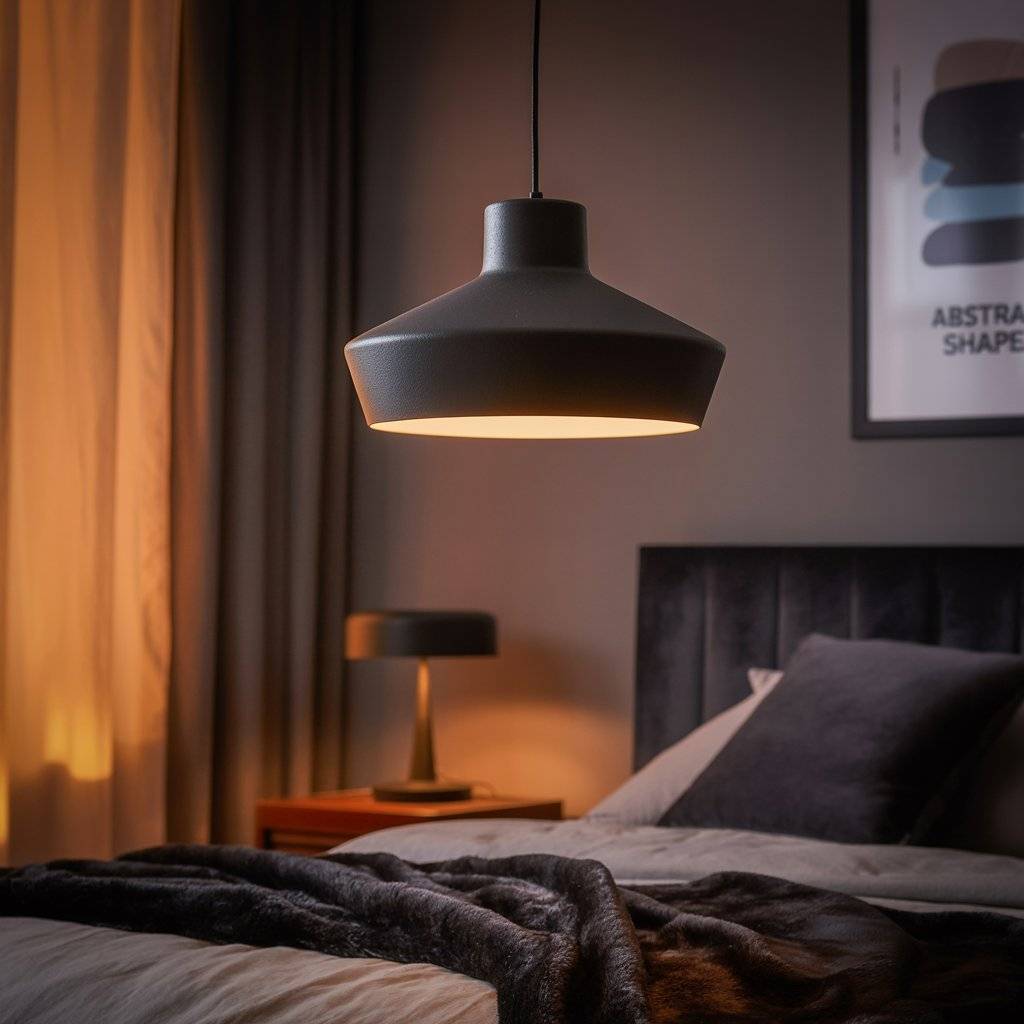
While you’ll mostly rely on ambient lighting, your ceiling light still matters. A moody bedroom benefits from a fixture that adds warmth and shape like a fabric drum shade, a vintage chandelier, or a matte black pendant. Pair it with a dimmer switch to control the brightness as needed.
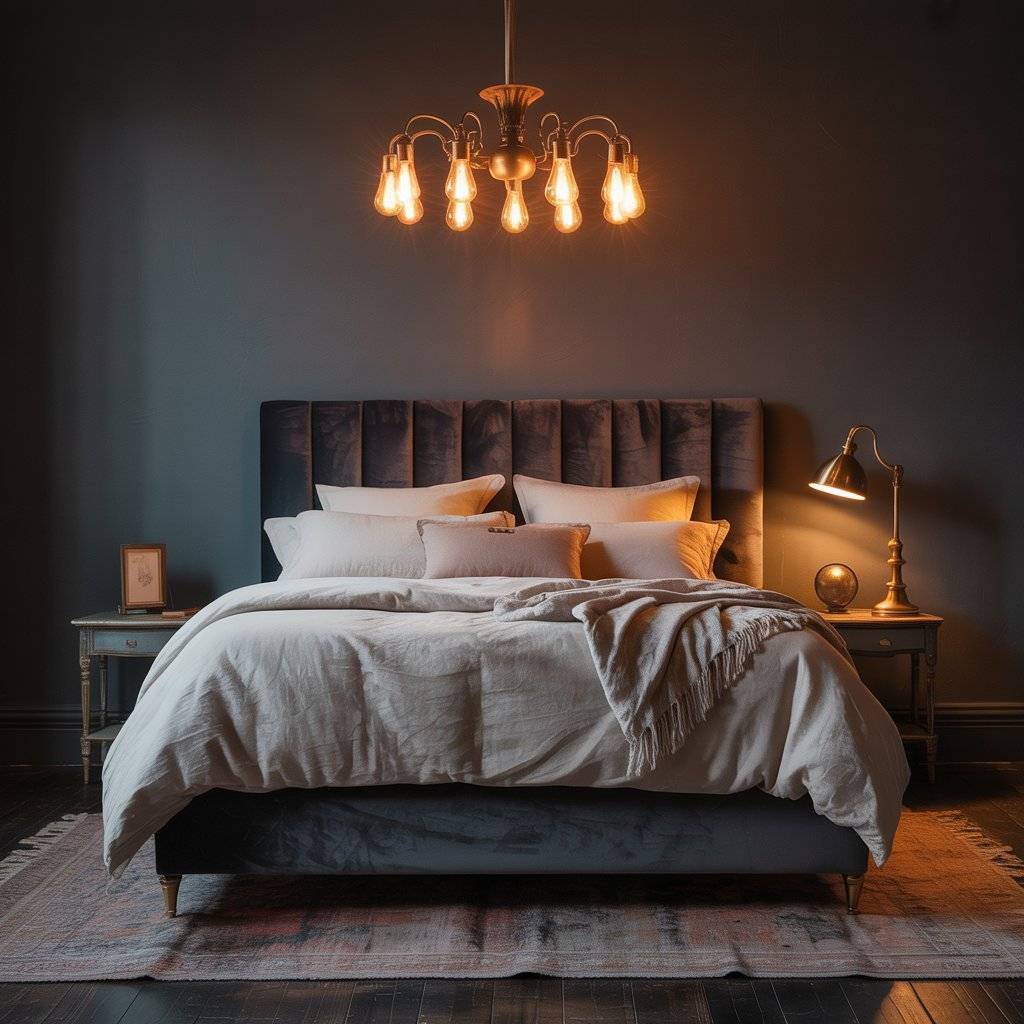
Choose Deep Colored Rugs
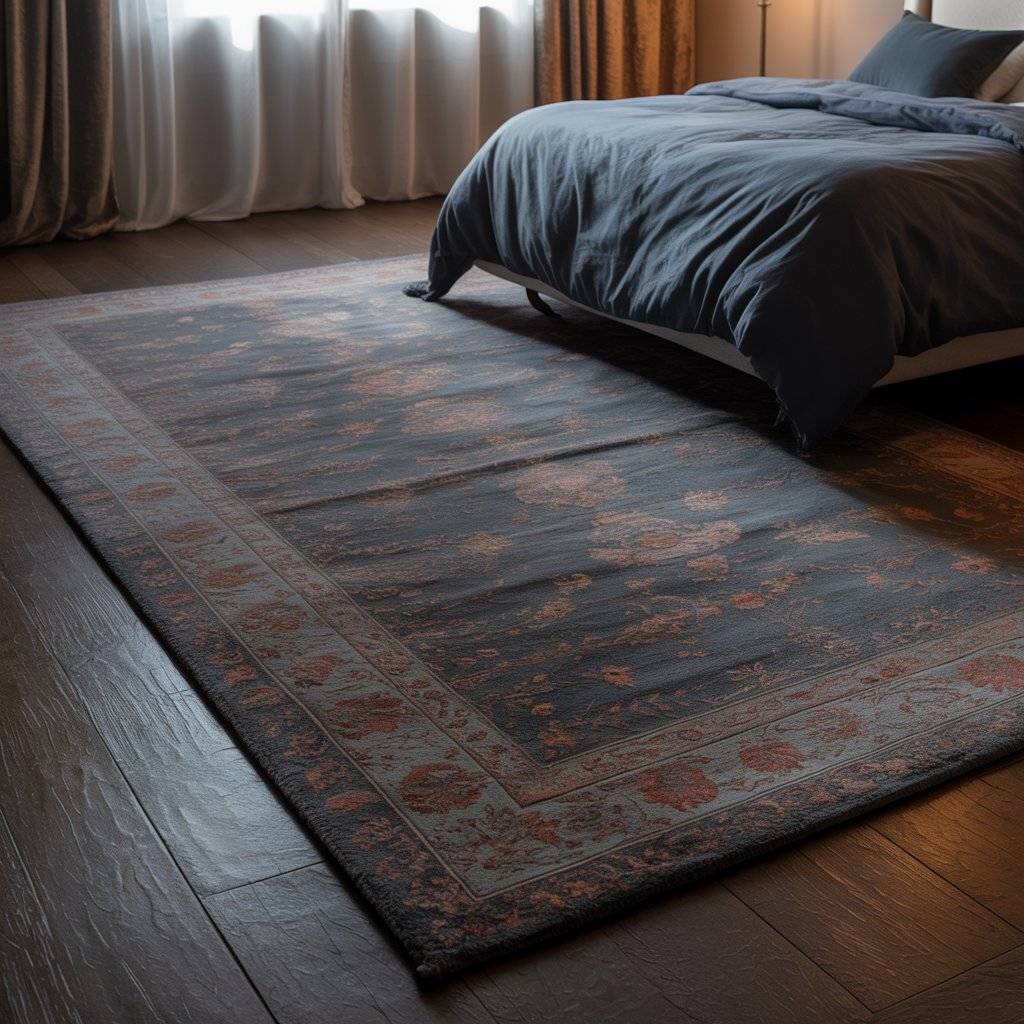
Dark area rugs ground the space visually and make it feel cozy underfoot. Look for patterns in muted tones like faded florals, kilims, or solid shades of gray, navy, or rust. Rugs help soften hard flooring and define the sleeping area without needing to remodel anything.
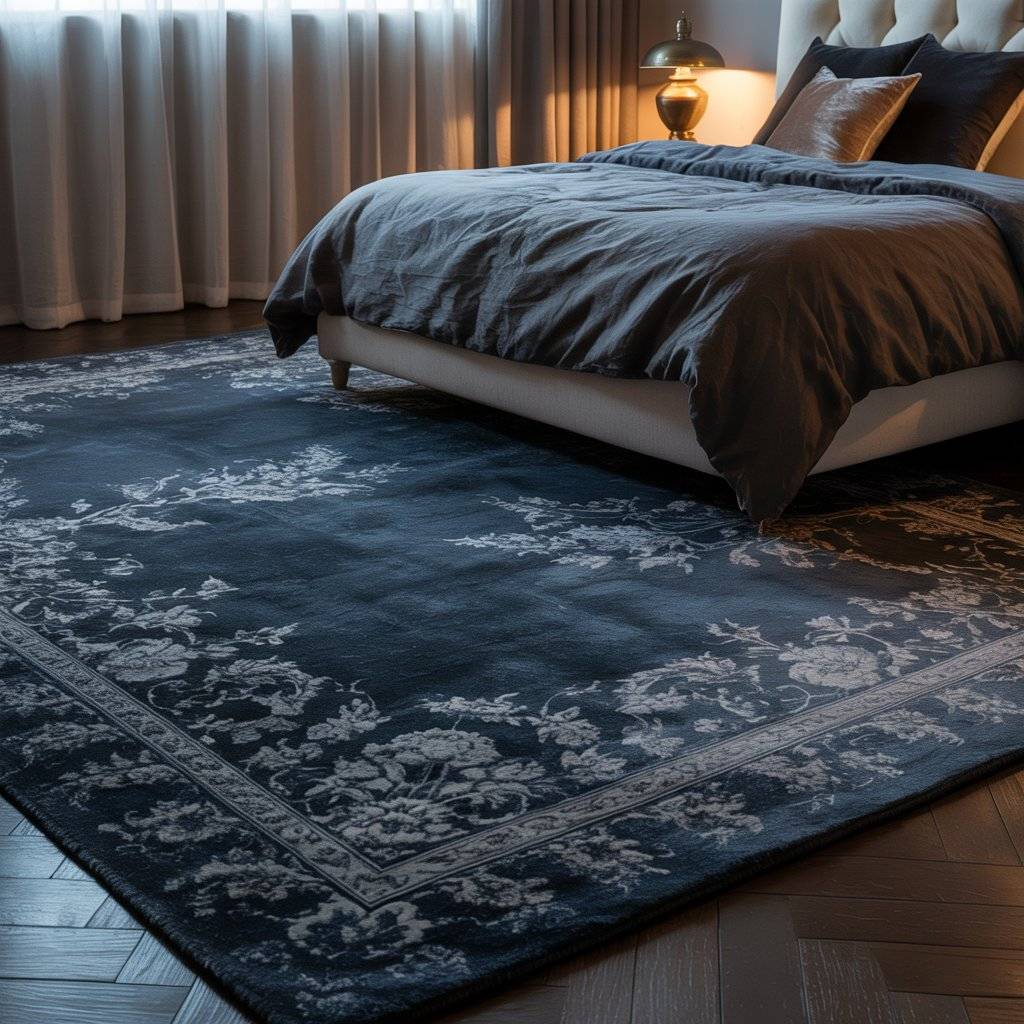
Paint the Ceiling
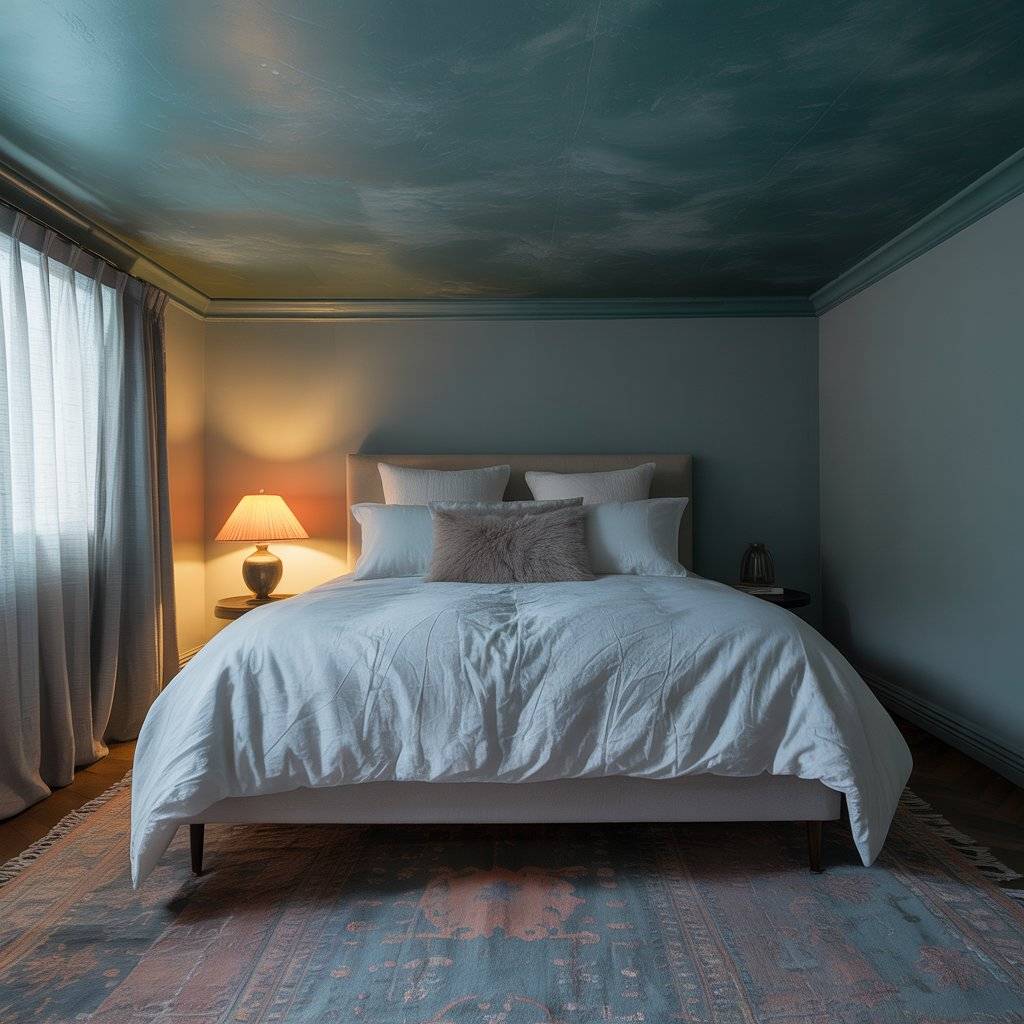
Painting your ceiling a shade or two lighter or darker than the walls can create a dramatic cocoon effect. This trick is especially useful in small bedrooms or ones with lower ceilings. It adds depth and creates a more unified space. Choose matte paint for a soft finish that doesn’t reflect too much light.
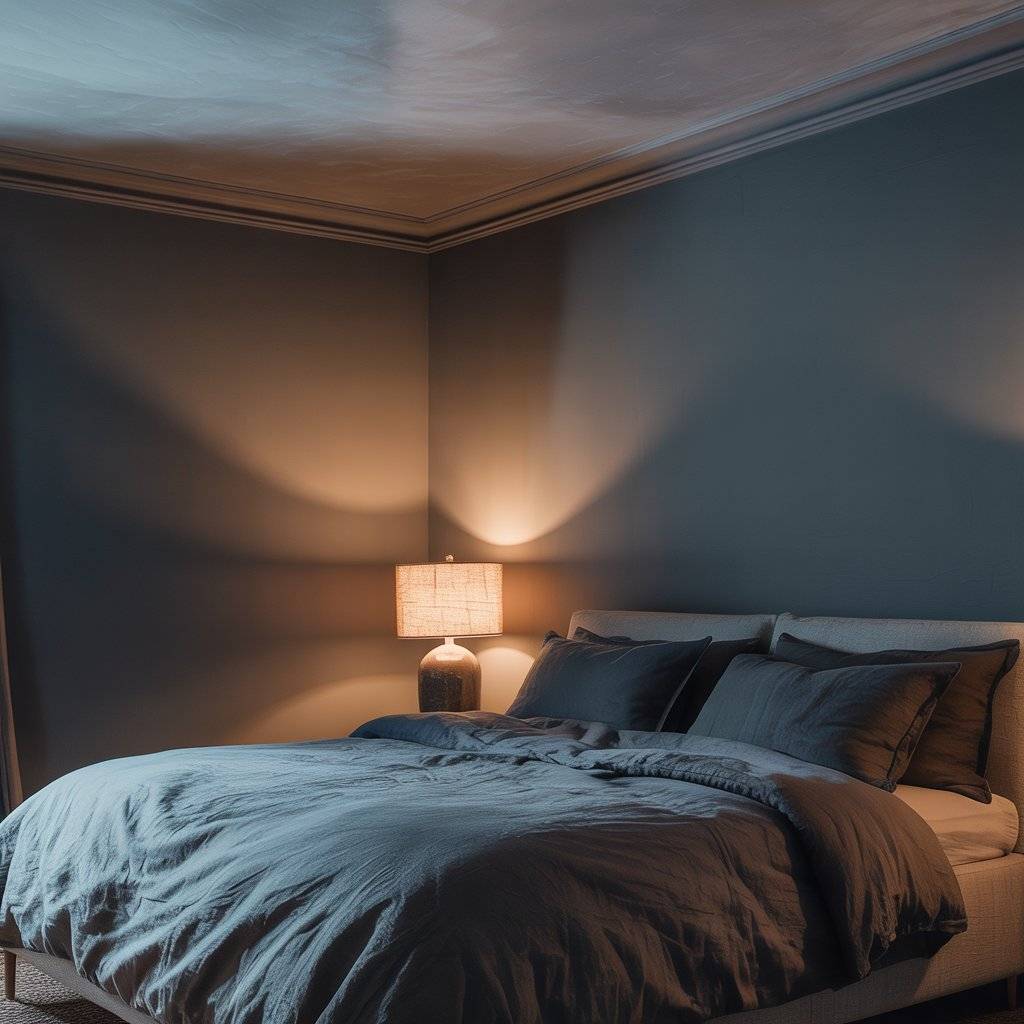
Use Open Shelving with Purpose
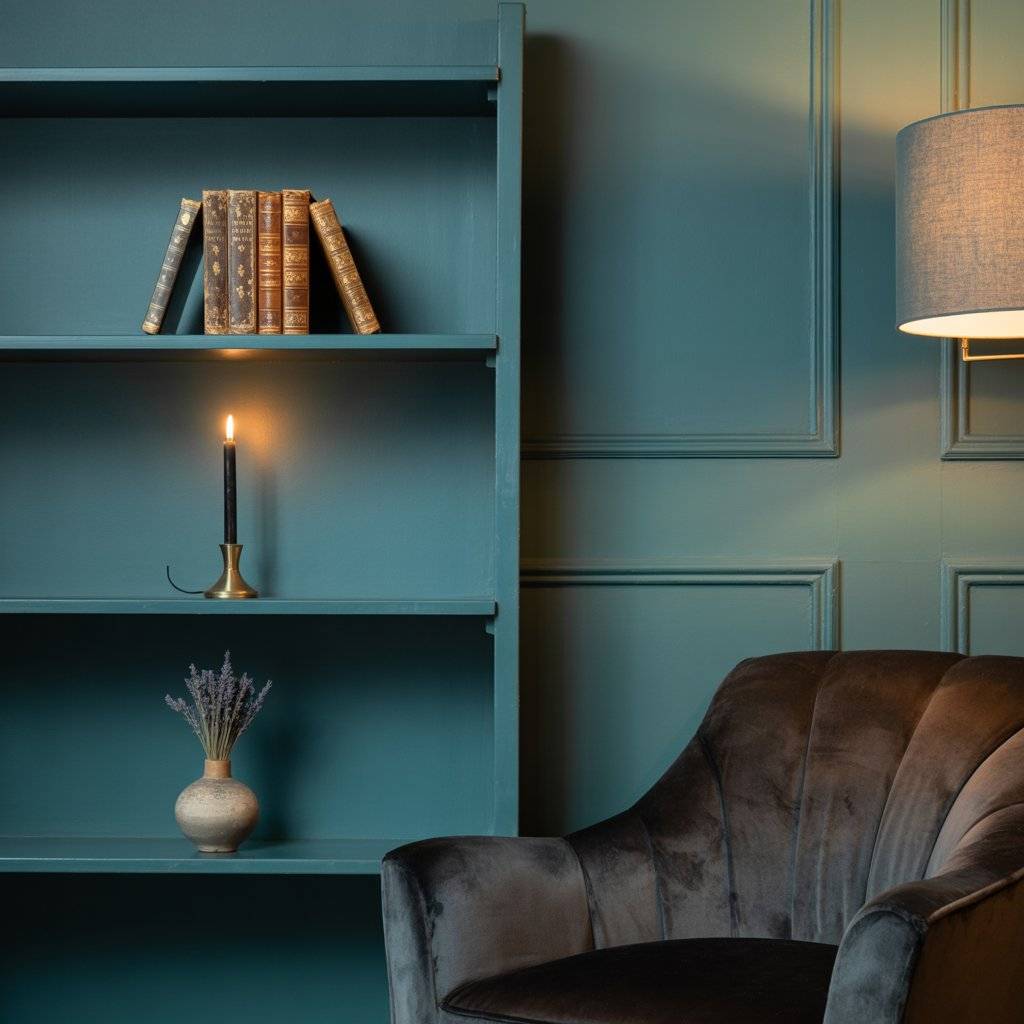
Instead of bulky storage furniture, open shelving can create moody visual moments. Use shelves to display a few meaningful books, candles, or simple decor in rich tones.
Stick to just a few items per shelf so the space feels curated, not busy. It’s a great way to add personality without crowding the room.
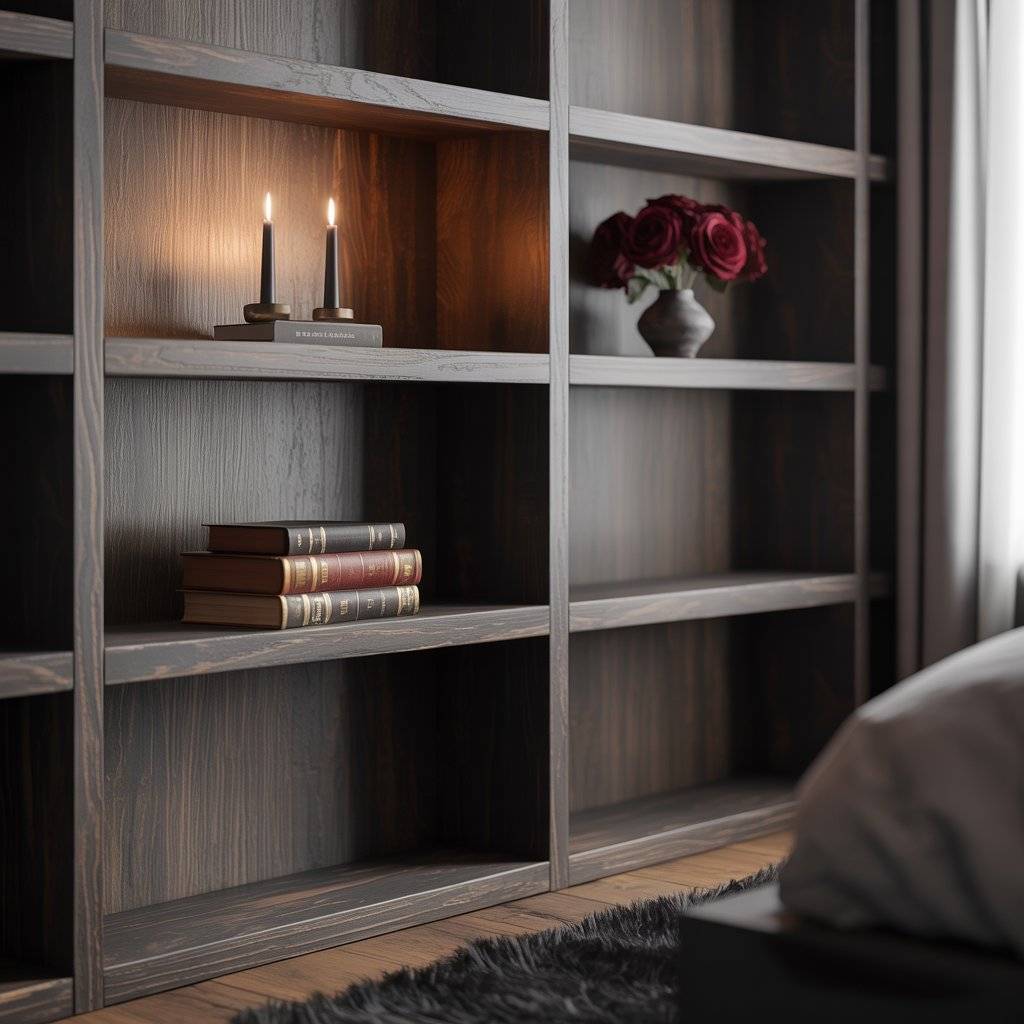
Add Leather or Suede Accents
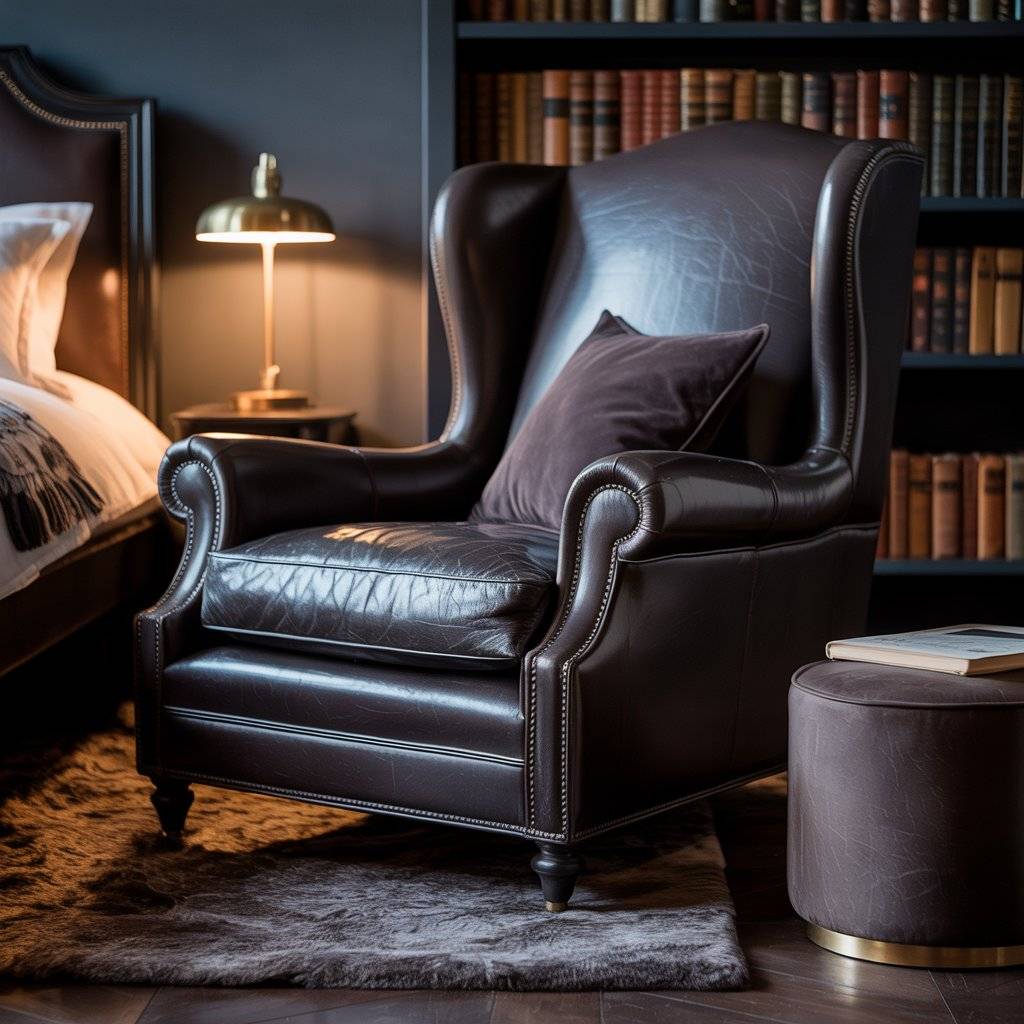
Rich materials like leather or suede add texture and a quiet sense of luxury. A leather chair, suede throw pillow, or small ottoman can bring warmth and visual interest.
Choose neutral or darker tones so they blend into the room’s overall palette. These elements wear well over time and fit naturally into a moody space.
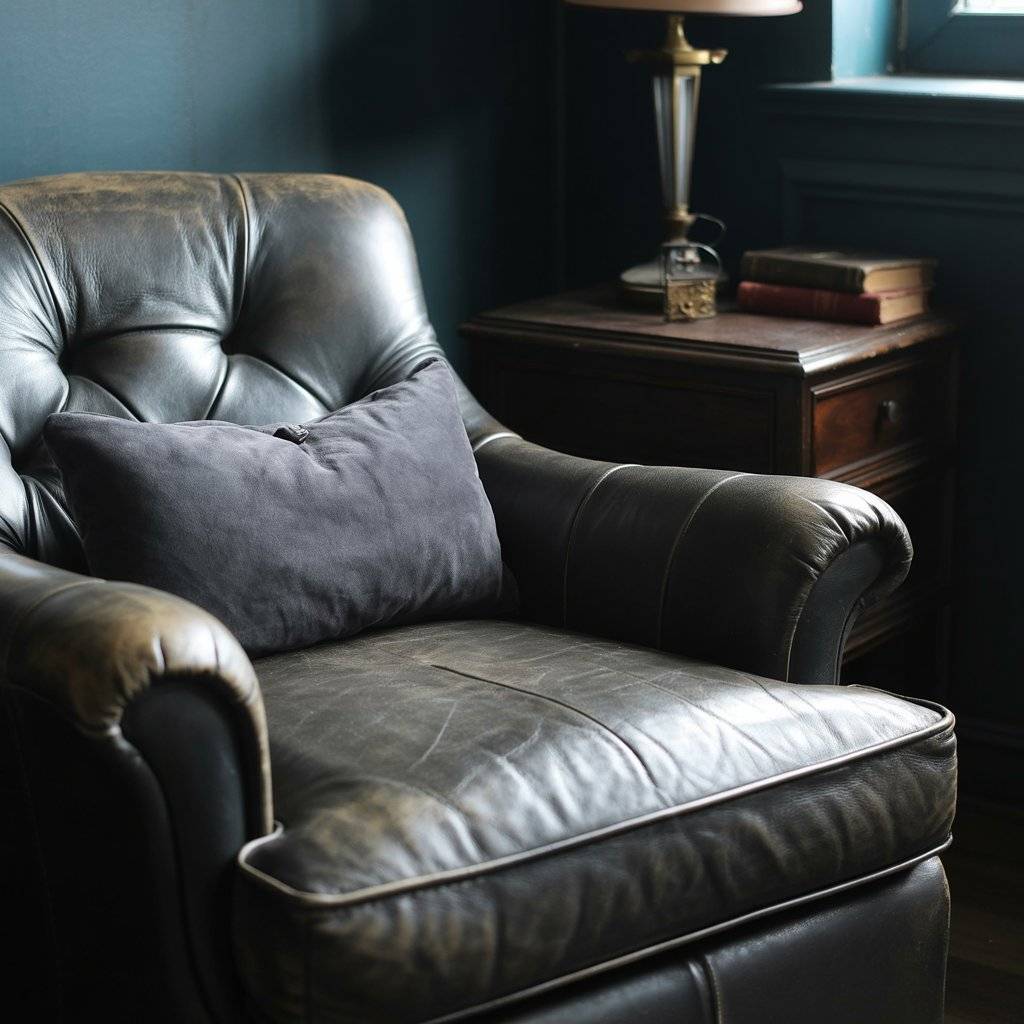
Mix Cool and Warm Tones
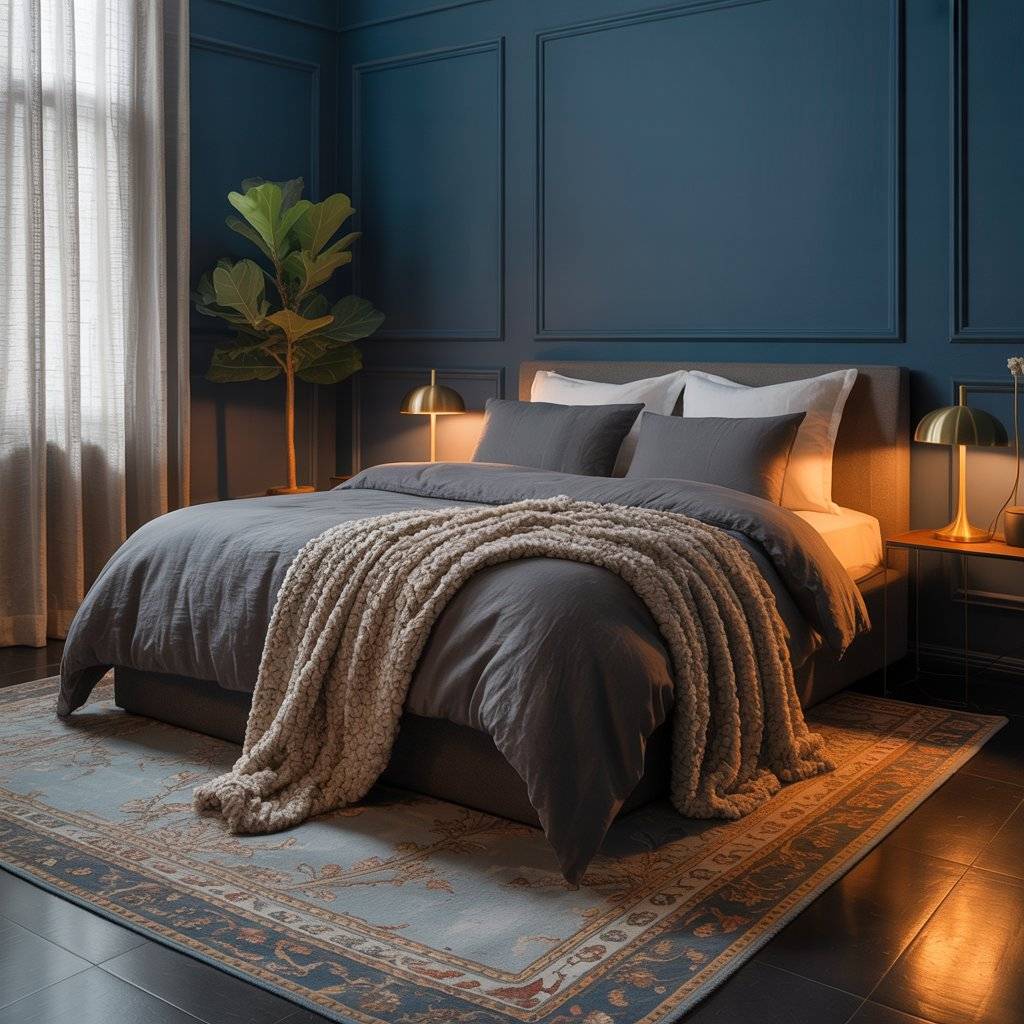
Too many cool tones can feel flat. Too many warm tones can feel heavy. Mix the two for balance pair deep blue walls with brass lamps, or charcoal bedding with warm wood. This contrast helps your space feel lived-in and layered, not one-dimensional.
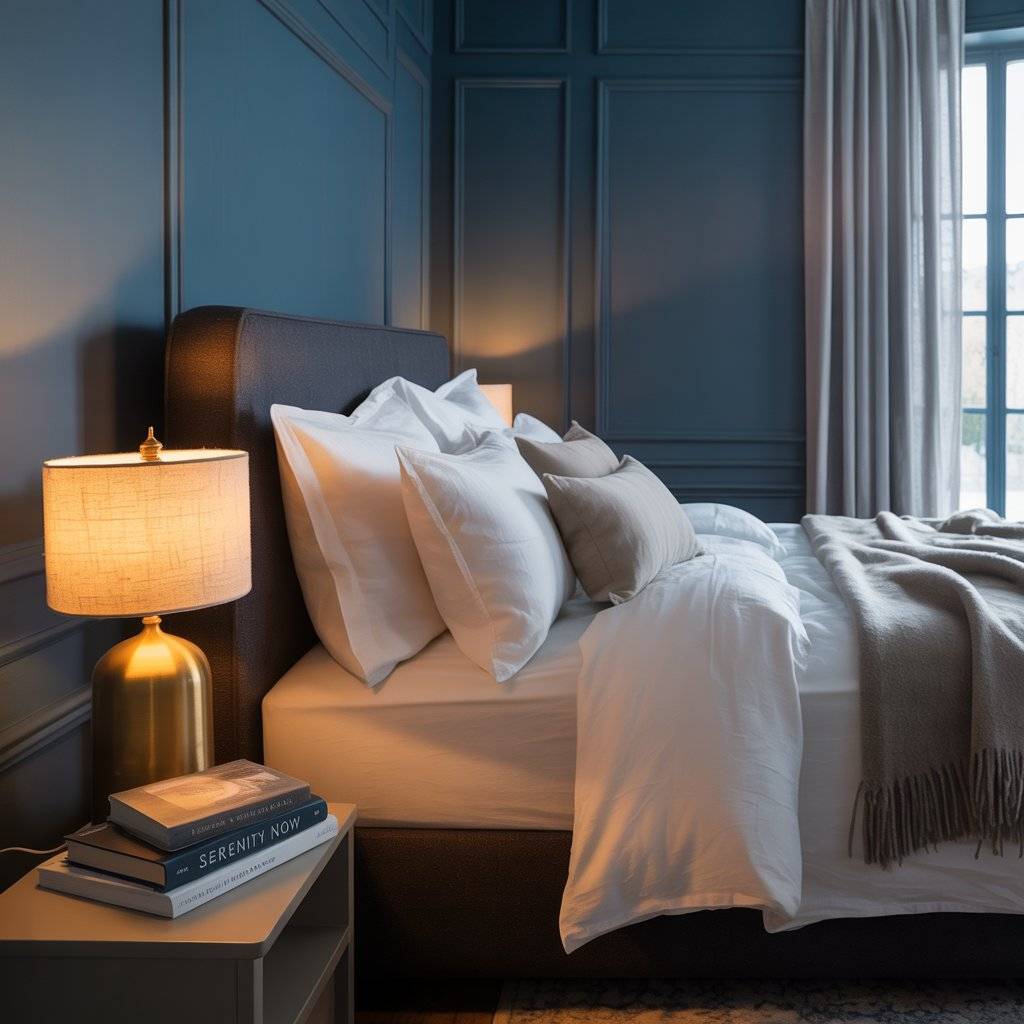
Let One Element Stand Out
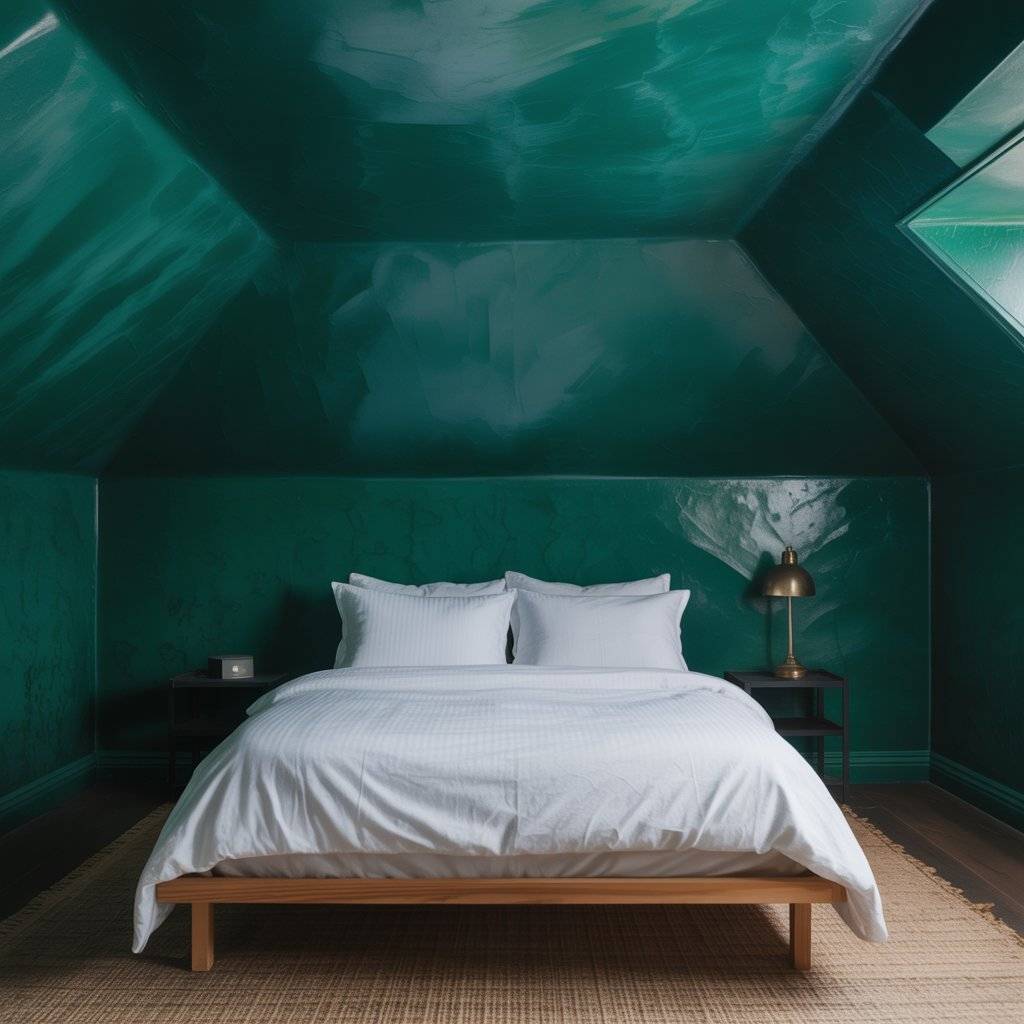
Pick one bold feature to focus on: a dramatic piece of art, a striking headboard, or a colored ceiling. Let it lead the room’s design and keep the rest simple.
This approach helps the space feel intentional without trying too hard. A moody room works best when it feels personal, not styled for someone else.
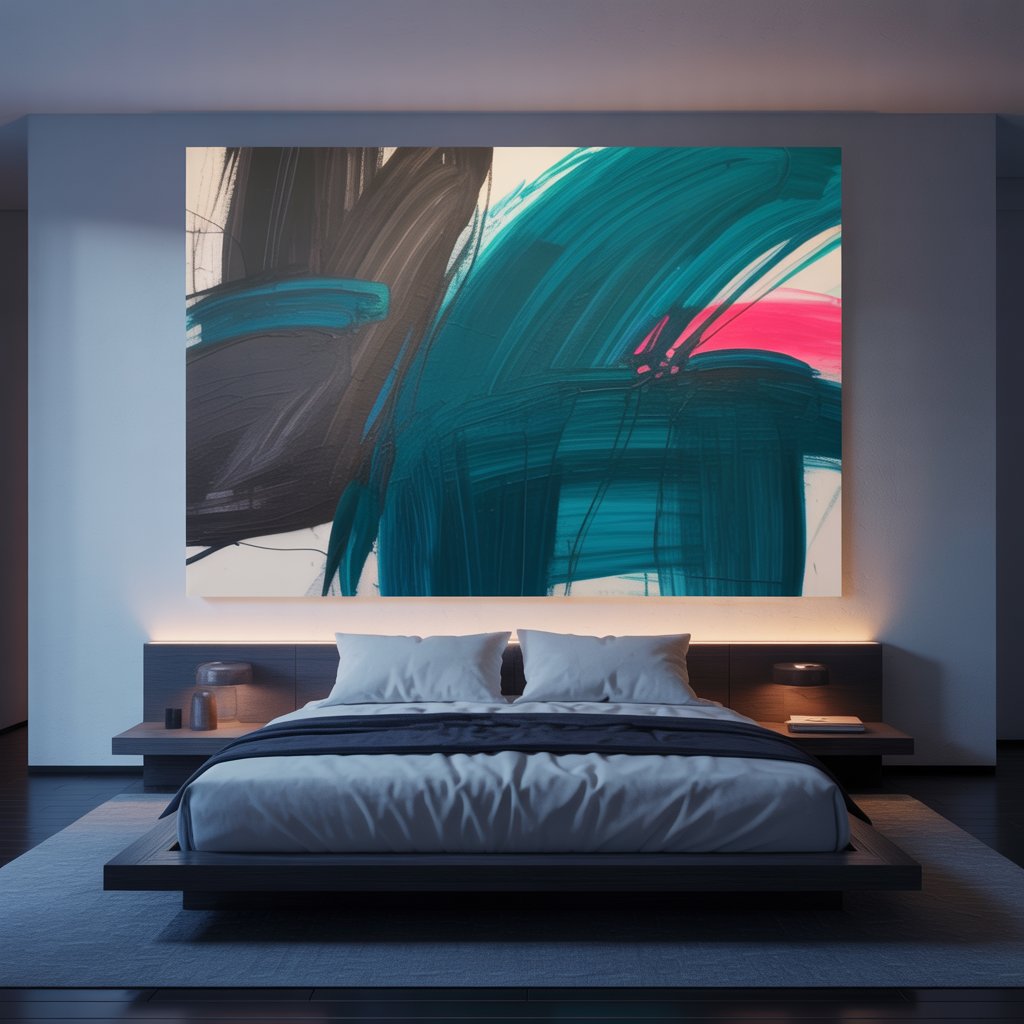
Why I Wrote This Article
- ✅ Help You Make the Most of Your Bedroom
Your bedroom should be more than a place to sleep it should reflect how you want to feel. I wrote this to show how mood, color, and texture can change not just the look of a space, but how you experience it.
- ✅ Break Down the Idea of “Moody Design
Moody bedrooms are often seen as dark or dramatic in a way that feels out of reach. I wanted to simplify the concept and show that anyone can create this feeling with a few thoughtful changes.
- ✅ Offer Real, Doable Ideas
Not everyone has time or money for a full makeover. This list includes practical things you can try today even something as simple as swapping a lamp or changing your bedding.
- ✅ Support Calm, Comforting Spaces
We all need a place to slow down. Moody bedroom design helps create that kind of calm, and this guide was written to help you build it without stress or overthinking.
- ✅ Inspire Without Overwhelming
I didn’t want to just show you pretty rooms I wanted to give you a path. This list is about steps you can take, in your own time, that feel right for your space.
- ✅Because I Love What This Style Can Do
As someone who finds peace in dim light, quiet textures, and rich color, I believe in the power of moody bedrooms to support real rest. That’s worth sharing.
Final Thoughts
Bringing mood into your bedroom it means choosing elements like deeper colors, softer lighting, and quieter textures that make your space feel more like you. All you try one idea or several, each step helps shape a room that supports your downtime, your peace, and your personal style.
If something in this article helped spark an idea, I hope you give it a try no pressure, no perfection needed.
So take your time, dim the lights, and start small.
Even swapping a lampshade or layering new bedding can be a meaningful first step.
And if you ever find yourself lying in bed, wrapped in a blanket with a cup of tea nearby, thinking “this just feels right” then you’ve done it. You’ve created your own version of cozy and moody. And that’s the best kind of design there is.
Related Post:
- 24 Unique Eco friendly Tents and Sustainable Camping Shelters - January 6, 2026
- 27 Eco Friendly Product Crafts to Make and Sell from Home - January 6, 2026
- 18 Back to School Eco-Friendly Products Every Student Needs - January 5, 2026

